Spring is a beautiful season when nature comes back to life, and the skies are full of beautiful colors and melodies of birds. The arrival of spring triggers an array of various bird species that migrate to new habitats, while others come out of hibernation.
Birds are an essential part of nature, and their beautiful songs and vibrant colors bring joy to our lives. From bright yellow warblers to bold blue jays, and delicate hummingbirds, the diversity of bird species that we can witness during spring is truly remarkable.
Therefore, in this article, we have compiled a comprehensive list of spring birds that you can spot during this season.
1. Thrush
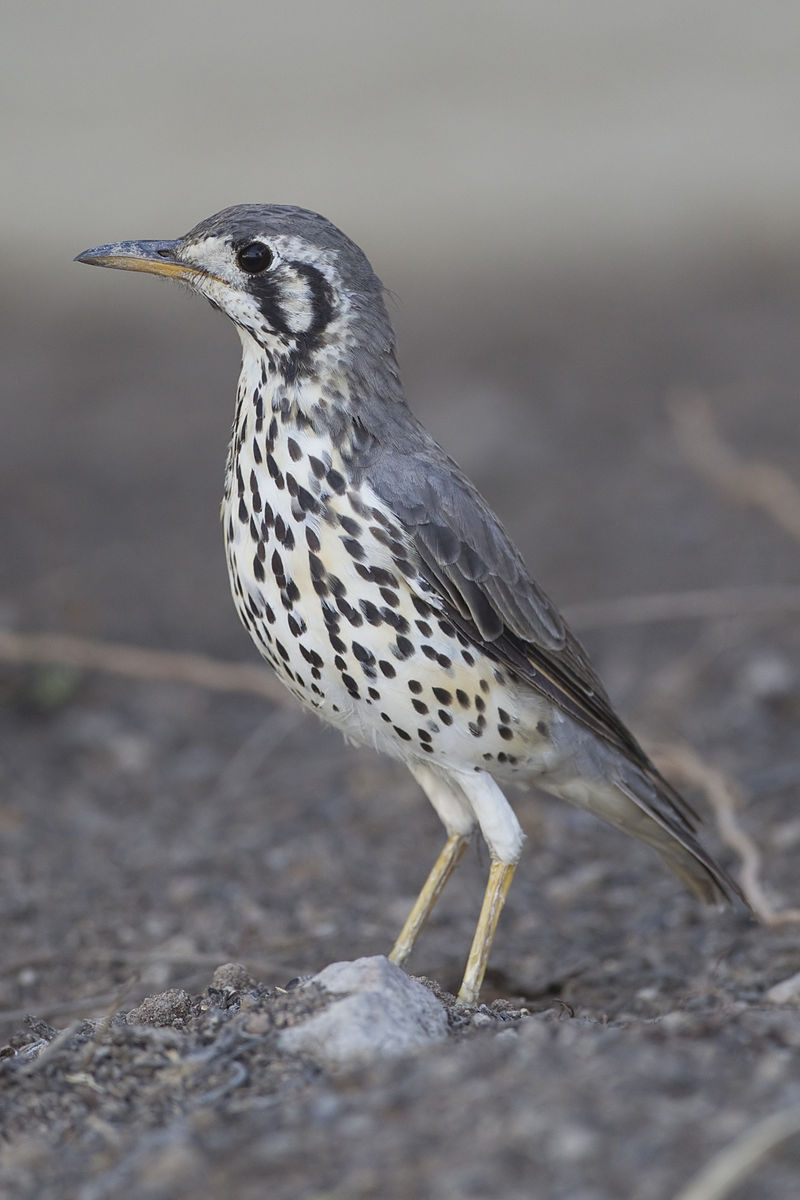
Thrushes are small to medium-sized birds belonging to the Turdidae family, and found all over the world. They live on or near the ground and feed on insects, other invertebrates and fruit.
Their feathers range from greyish browns to deep blues in colour with spotted wings that help them blend into their natural habitats such as forests, woodlands and shrubs.
Thrushes have distinctive songs which they sing during spring mating season; many species also perform complex flight displays for courtship rituals.
These birds may be solitary creatures but can often be seen foraging together in groups or pairs when searching for food sources like worms, snails or berries.
A healthy thrush population is an indication of a balanced environment since they require clean water sources as well as plenty of vegetation cover – making them important indicators of ecosystem health worldwide.Scientific classification:
| Kingdom | Animalia |
| Phylum | Chordata |
| Class | Aves |
| Order | Passeriformes |
| Suborder | Passeri |
| Family | Turdidae Rafinesque, 1815 |
Also Featured In: Common Birds in India, Most Common Romanian Birds
2. Northern Cardinal

The Northern Cardinal is a beautiful bird, easily identified by its bright red plumage. It can be found in the eastern United States from Maine to Minnesota and south through Mexico and Belize.
Along with its striking colouration, it has a distinctive crest on its head and sharp black facial markings around the eyes.
Despite their small size (measuring 7-9 inches) they are very vocal birds – males sing persistently throughout springtime to attract mates or proclaim their territory.
They typically feed on insects, seeds and fruits but also enjoy suet at backyard bird feeders.
The female is less brightly coloured than her mate but still stands out among other songbirds due to her warm brownish-red feathers.
Cardinals pair for life so you may often see them together in your garden or neighbourhood park.Scientific classification:
| Kingdom | Animalia |
| Phylum | Chordata |
| Class | Aves |
| Order | Passeriformes |
| Family | Cardinalidae |
| Genus | Cardinalis |
| Species | C. cardinalis |
Also Featured In: Most Common United States Birds, Birds for Your Home Garden
3. American Robin

The American robin is a migratory bird, belonging to the true thrush genus and Turdidae family.
It was named after its European counterpart due to the similar reddish-orange breast they both possess; however, they are not related closely.
This species can be seen through most of North America during winter months, as well as in parts of Mexico and Central America where it also breeds.
They have plump bodies with gray upperparts and white underparts that vary from yellow on their throats down to orange toward their bellies.
Robins feed on fruits such as berries or insects like worms which makes them an important part of ecosystems by helping disperse seeds naturally throughout these areas.Scientific classification:
| Kingdom | Animalia |
| Phylum | Chordata |
| Class | Aves |
| Order | Passeriformes |
| Family | Turdidae |
| Genus | Turdus |
| Species | T. migratorius |
Also Featured In: Blue Birds You’ll Found around Us, Birds Live in Arkansas
4. Northern Mockingbird
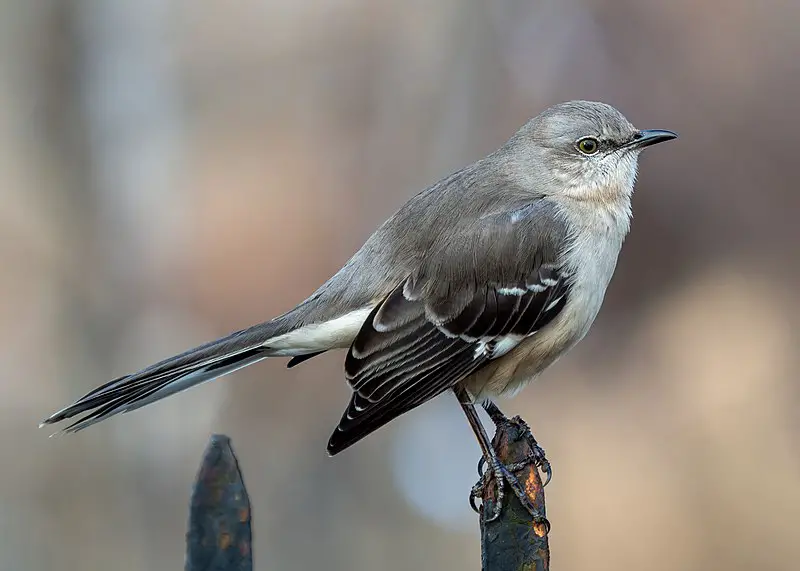
The northern mockingbird is a common fixture in North American skies. It has greyish-brown upperparts and a paler underside with white wing patches, and its distinctive long tail makes it easy to spot.
This adaptable bird can often be seen singing from the tops of trees or fences, though it rarely strays into Europe.
The species was first described by Carl Linnaeus in his 1758 Systema Naturae as Turdus polyglottos – aptly named for their remarkable ability to mimic other birds’ songs.
Northern mockingbirds typically live on insects, fruits, berries and seeds but they will also happily scavenge food scraps left out by humans.
With its beautiful song and striking plumage this beloved avian makes an important contribution to our environment.Scientific classification:
| Kingdom | Animalia |
| Phylum | Chordata |
| Class | Aves |
| Order | Passeriformes |
| Family | Mimidae |
| Genus | Mimus |
| Species | M. polyglottos |
Also Featured In: Birds that Live in San Francisco Bay Area, Birds that Live in Mississippi
5. American Goldfinch
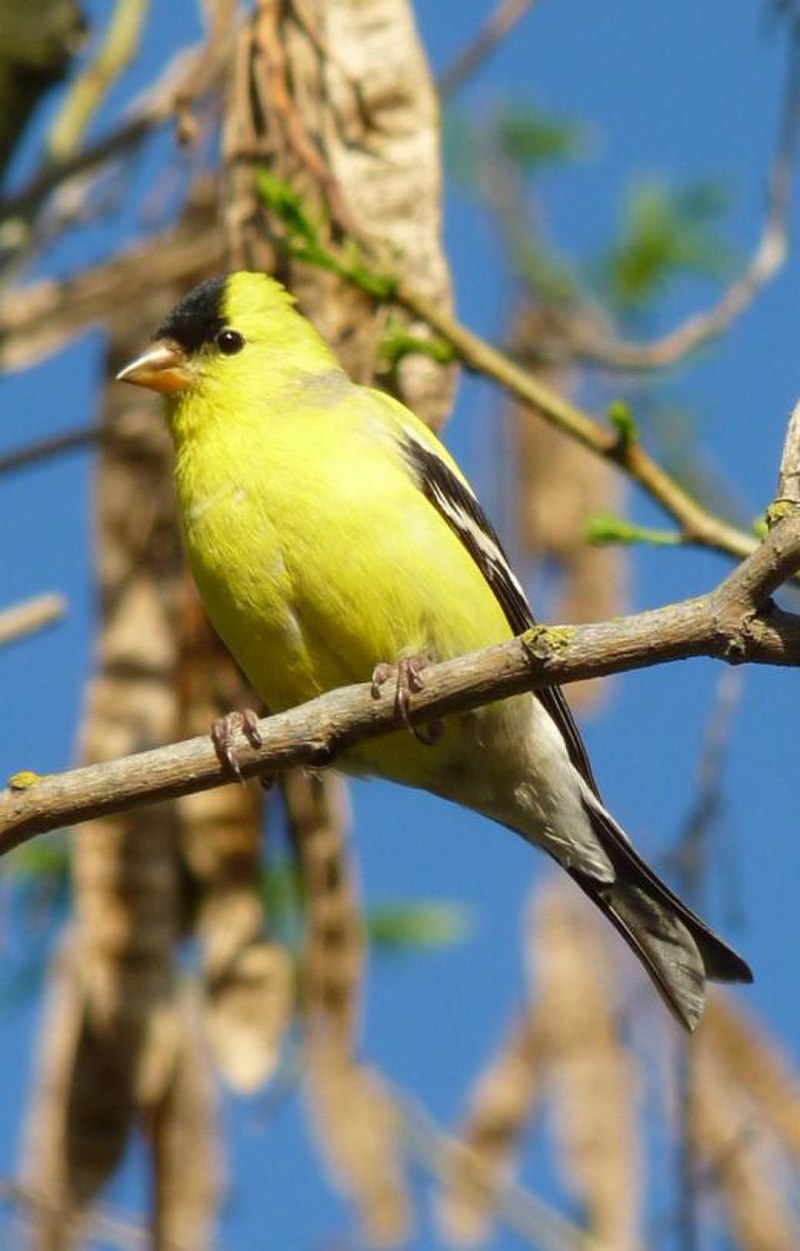
The American goldfinch is a small North American bird in the finch family. Males are vibrant yellow with black wings and tail, while females are duller in colouration.
It migrates from mid-Alberta to North Carolina during breeding season, south of Canada–United States border to Mexico for its wintering grounds.
The only finch which undergoes complete molt every year, it displays sexual dichromatism where males have brighter colours than their female counterparts.
They feed mainly on seeds but also eat insects such as aphids and caterpillars when raising youngs; they often occur near thistles or other plants that produce viable seed heads.
Their call consists of an array of chirps and trills making them quite conspicuous.Scientific classification:
| Kingdom | Animalia |
| Phylum | Chordata |
| Class | Aves |
| Order | Passeriformes |
| Family | Fringillidae |
| Subfamily | Carduelinae |
| Genus | Spinus |
| Species | S. tristis |
Also Featured In: New Hampshire Birds You Should Know, Common Southern Californian Birds
6. Songbirds
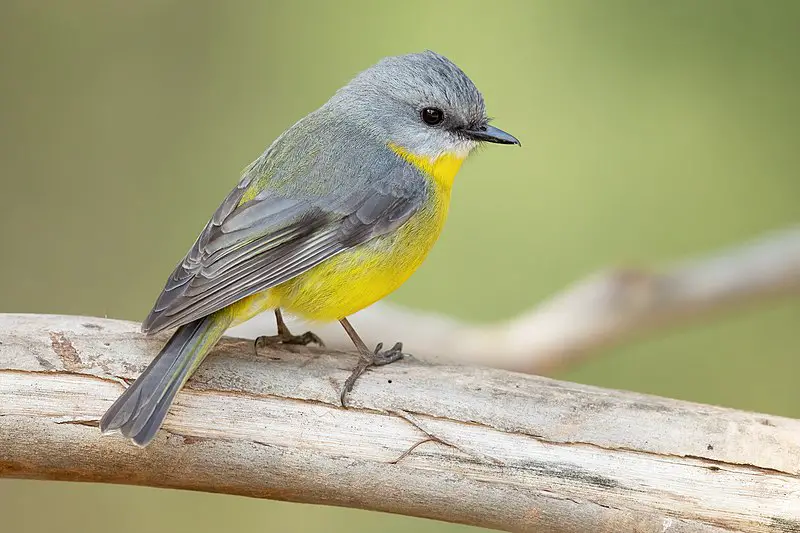
Songbirds are a special suborder of perching birds found all over the world. These beautiful creatures have intricate vocal organs that allow them to produce elaborate bird songs, making them stand out from other species.
With around 5,000 different types of songbird in existence, they come in various sizes and colors with complex feathers adding to their beauty.
Songbirds play an important role in eco-systems as they help disperse seeds by eating fruit and insects which act as agents for pollination.
Their presence also serves to attract more biodiversity into areas where these delicate animals live, creating vibrant habitats full of life.Scientific classification:
| Kingdom | Animalia |
| Phylum | Chordata |
| Class | Aves |
| Order | Passeriformes |
| Clade | Eupasseres |
| Suborder | Passeri Linnaeus, 1758 |
Also Featured In: Famous Paintings Birds, Common Birds in the Cities
7. Bluebirds
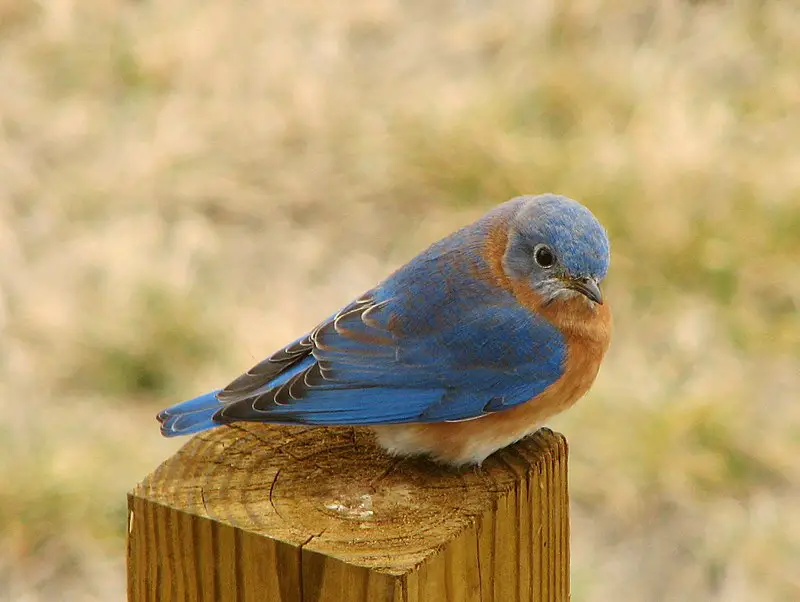
Bluebirds are a North American species of small to medium-sized birds belonging to the thrush family. They have stunning blue and rose beige plumage, with males having brighter colors than females.
These beautiful birds mainly feed on insects, but they can also eat some fruits or seeds from time to time. Bluebirds reside in open fields, meadows and backyards across much of North America.
Their cheerful songs bring joy as they fly through their habitats looking for food during the day before returning home at nightfall.
The sight of these beautiful creatures is often associated with happiness and hope – making them beloved by many people.Scientific classification:
| Kingdom | Animalia |
| Phylum | Chordata |
| Class | Aves |
| Order | Passeriformes |
| Family | Turdidae |
| Subfamily | Myadestinae |
| Genus | Sialia Swainson, 1827 |
Also Featured In: House Birds You’ll Love to Pet, Birds of Symbolism
8. Black-Capped Chickadee

The black-capped chickadee is a small and cheerful songbird found in deciduous and mixed forests across North America. It has an iconic black cap, white cheeks, gray back and wings with whitish bars on them.
The underparts are usually light colored or greyish brown. This species is well adapted to cold winters as it can reduce its body temperature by up to 8°C while roosting at night; this helps save energy during the colder months of the year.
It feeds mainly on insects but also eats seeds, fruits and suet from bird feeders when available.
Black-capped chickadees are popular birds among backyard visitors due to their sociable nature – they often establish lifelong partnerships with one another for breeding purposes.
Furthermore, they have been designated as state birds of Massachusetts and Maine in USA plus New Brunswick in Canada – a testament to how beloved these little avian friends truly are.Scientific classification:
| Kingdom | Animalia |
| Phylum | Chordata |
| Class | Aves |
| Order | Passeriformes |
| Family | Paridae |
| Genus | Poecile |
| Species | P. atricapillus |
Also Featured In: Summer Birds that Live around Us, Autumn Birds You Should Know
9. Wrens
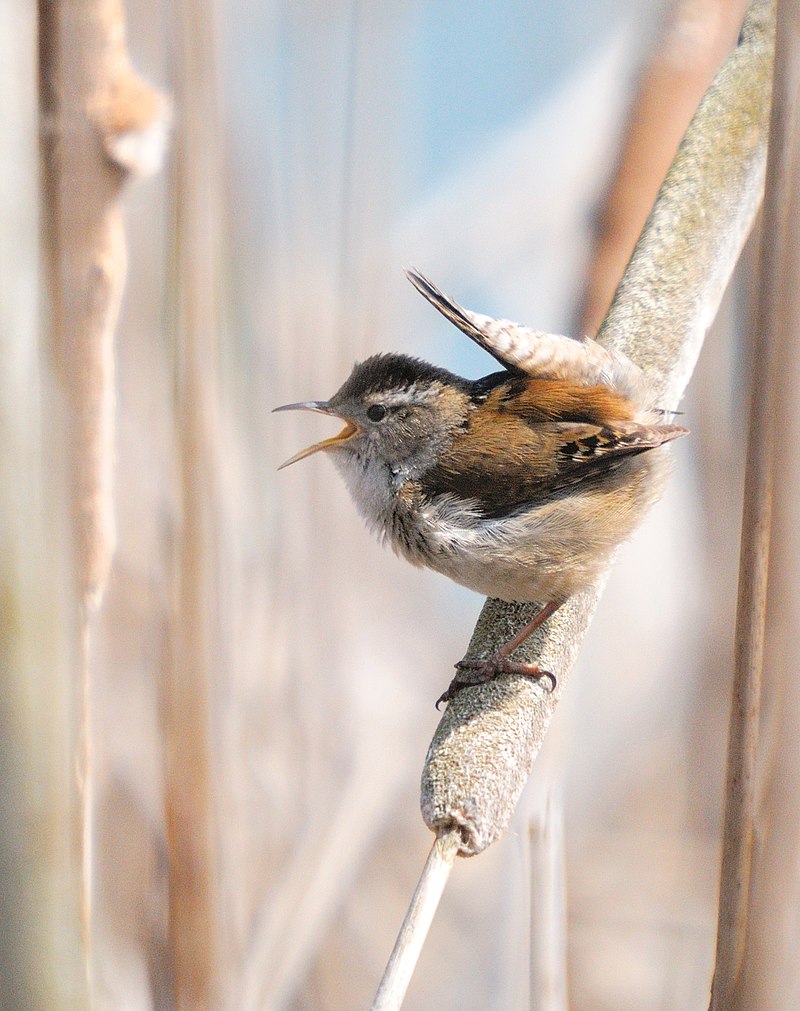
Wrens are a family of small brown passerine birds found mainly in the Americas. They are considered one of the most abundant bird species, with 88 known varieties divided into 19 genera.
The Eurasian wren is the only type that inhabits Europe and other parts of the Old World, where it’s commonly referred to simply as “wren.”
This species has been given its name due to similar-looking unrelated birds living elsewhere such as New Zealand wrasses.
Wrens have tiny bodies with thin bills and long tails which they often hold upright for hours at a time while singing their loud cheery songs from treetops or low shrubs.
Their diet consists mostly of insects but can also include fruits and seeds depending on availability in their habitat range.Scientific classification:
| Kingdom | Animalia |
| Phylum | Chordata |
| Class | Aves |
| Order | Passeriformes |
| Superfamily | Certhioidea |
| Family | Troglodytidae Swainson, 1832 |
Also Featured In: Common Denmark Birds, Most Common Scotland Birds
10. Eastern Bluebird
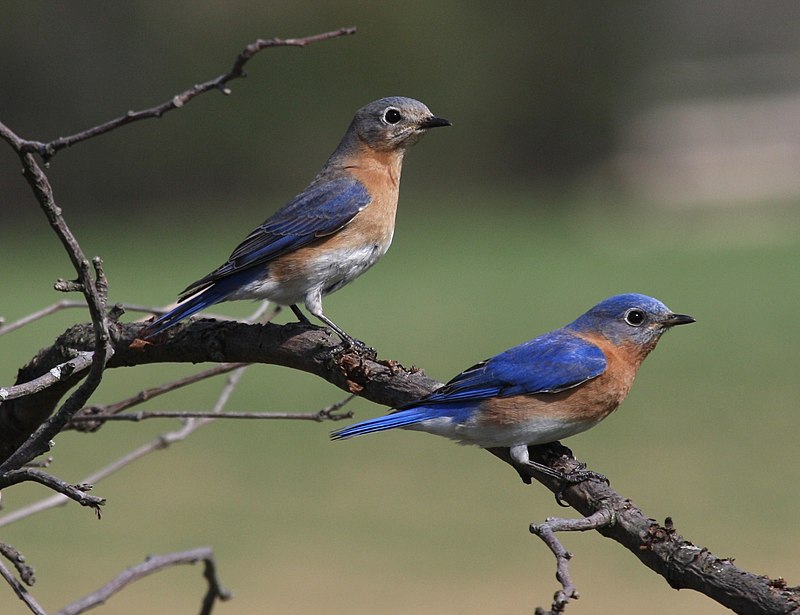
The Eastern bluebird is a small migratory thrush that can be found in open woodlands, farms and orchards across North America.
The male has bright-blue breeding plumage which makes it easily recognizable by birders.
It produces melodious songs such as jeew, chir-wi and chiti WEEW wewidoo.
This popular species was declared the state bird of Missouri back in 1927 due to its beauty and charm.
In addition to being beautiful, these birds are also beneficial for farmers because they eat insects like grasshoppers and beetles which damage crops.
They nest in cavities so providing nesting boxes helps them thrive even more.
With their vibrant colors, sweet melodies and helpful nature it’s easy to see why the Eastern Bluebird is beloved worldwide.Scientific classification:
| Kingdom | Animalia |
| Phylum | Chordata |
| Class | Aves |
| Order | Passeriformes |
| Family | Turdidae |
| Genus | Sialia |
| Species | S. sialis |
Also Featured In: Birds that Migrate through Illinois in the Spring, Birds in Iowa Spring
11. Baltimore Oriole
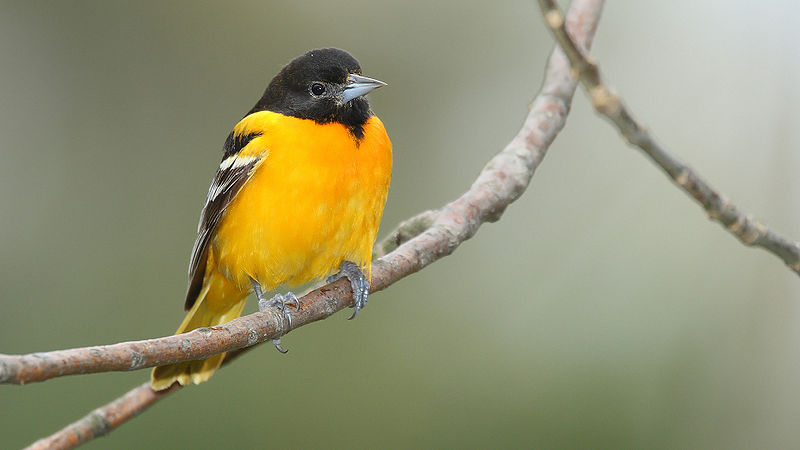
The Baltimore Oriole is a small, blackbird-like bird found in eastern North America. It’s named for the resemblance of its male colors to those on Lord Baltimore’s coat-of-arms from 17th century.
These birds migrate and breed during springtime and are quite common in their habitats.
Studies have shown that this species interbreeds with western Bullock’s orioles, leading both to be classified as a single species – Icterus galbula.
The males typically have orange feathers along the chest, back, wings and tail while females display tan or yellowish shades instead of bright orange ones like males do.
Both sexes share white wing bars and dark brown eyes which makes them easily distinguishable among other birds.
They can often be seen flitting around trees feeding off nectar buds or insects such as grasshoppers & caterpillars they catch while flying around.Scientific classification:
| Kingdom | Animalia |
| Phylum | Chordata |
| Class | Aves |
| Order | Passeriformes |
| Family | Icteridae |
| Genus | Icterus |
| Species | I. galbula |
Also Featured In: Birds that Calls in the Morning, Common Birds in Saskatchewan
12. Blue Jay

The Blue Jay is a beautiful bird that resides in eastern and central United States, as well as Newfoundland Canada.
They have an unmistakable blue colored plumage with white markings on their heads and wings.
These birds are highly adaptable to different habitats ranging from deciduous forests to urban areas.
As part of the Corvidae family, they are known for being intelligent problem solvers who will often use tools or mimic vocalizations of other species like hawks when defending their territories.
Their diet consists mostly of insects, seeds and nuts but can also include small vertebrates such as frogs or lizards if food resources become scarce.
Overall these birds provide much needed color to our environment while playing important roles in maintaining healthy ecosystems through pollination services and seed dispersal activities.Scientific classification:
| Kingdom | Animalia |
| Phylum | Chordata |
| Class | Aves |
| Order | Passeriformes |
| Family | Corvidae |
| Genus | Cyanocitta |
| Species | C. cristata |
Also Featured In: Most Common Nature Birds, Common Birds in Alberta
13. New World Warblers

New World warblers are an incredibly diverse family of small birds found only in the Americas. They range in size from tiny hummingbirds to large thrushes, and come in a variety of vibrant colors.
All have thin bills made for eating insects which form their main diet. Most species live predominantly arboreal lives, meaning they spend most of their time among trees or bushes searching for food.
However some members such as ovenbirds and waterthrushes prefer more terrestrial habitats like forest floors where they can scavenge for bugs on the ground instead.
Warblers provide a great source of entertainment with their beautiful songs often filling up woodlands during mornings and evenings throughout springtime.Scientific classification:
| Kingdom | Animalia |
| Phylum | Chordata |
| Class | Aves |
| Order | Passeriformes |
| Superfamily | Emberizoidea |
| Family | Parulidae Wetmore et al., 1947 |
Also Featured In: British Columbian Birds, Birds that Live in Faroe Islands
14. House Sparrow

The house sparrow is a small bird of the Passeridae family. It has an average length of 16 cm and weighs 24-39.5 gm.
Females have dull brown and grey plumage, whereas males are brighter, with black, white and brown markings on their wings and back feathers.
This species is one among 25 different kinds in its genus Passer .These birds are found all around the world mainly near human dwellings where they feed off food scraps from garbage bins or gardens etc..
They also make nests close to houses which makes them even more visible to people living nearby.
House sparrows can be seen hopping around yards looking for food during daytime hours but usually hide in colonies at night time.Scientific classification:
| Kingdom | Animalia |
| Phylum | Chordata |
| Class | Aves |
| Order | Passeriformes |
| Family | Passeridae |
| Genus | Passer |
| Species | P. domesticus |
Also Featured In: Ukrainian Birds You Should Know, Asian Birds
15. Red-Bellied Woodpecker
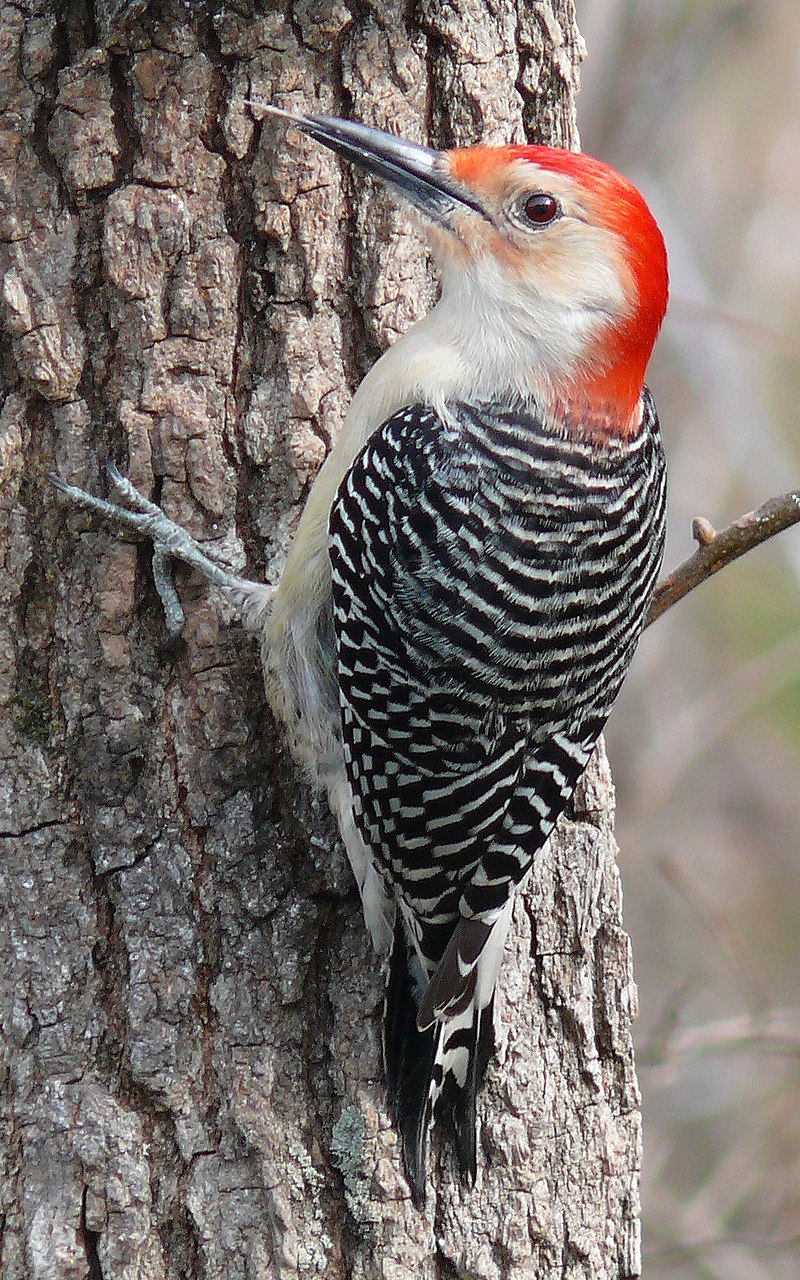
The Red-bellied woodpecker is a beautiful bird with an orange-red crown and nape. It breeds mainly in the eastern United States, ranging from Florida to Canada.
This medium-sized woodpecker of the family Picidae has black wings, white stripes on its back and tail feathers that are barred with black.
Its underside is mostly pale yellow or white but it also features some red coloration around its neck area.
Despite this subtle red hue, it should not be mistaken for the entirely red head and neck belonging to the Red-headed woodpecker of the same genus Melanerpes carolinus.
The Red bellied Woodpeckers diet consists primarily of insects such as ants, beetles and grasshoppers along with nuts fruits berries and tree sap which they will feed upon during different times throughout their life cycle.Scientific classification:
| Kingdom | Animalia |
| Phylum | Chordata |
| Class | Aves |
| Order | Piciformes |
| Family | Picidae |
| Genus | Melanerpes |
| Species | M. carolinus |
Also Featured In: Long Island Birds You Should Know, Common Central Park Birds
16. House Finch

The House Finch is a species of finch native to western North America and has been introduced in the eastern half of the continent as well as Hawaii.
It’s an average-sized finch with adults measuring 12.5 – 15 cm (5 – 6 inches) long and having wingspans between 20 – 25 cm (8 – 10 inches).
The upperparts are brown, while its underparts range from pale grayish white to yellow depending on subspecies.
Its face is streaked or spotted with reddish coloration; males typically have brighter plumage than females due to sexual dimorphism.
They’re mostly found near human habitations such as farms and gardens where they feed on grains, fruits, insects etc., making them very popular among birders who want something colorful for their backyard.Scientific classification:
| Kingdom | Animalia |
| Phylum | Chordata |
| Class | Aves |
| Order | Passeriformes |
| Family | Fringillidae |
| Subfamily | Carduelinae |
| Genus | Haemorhous |
| Species | H. mexicanus |
Also Featured In: Common Birds That Live in Las Vegas, Birds That Live around Seattle
17. Dark-Eyed Junco

The Dark-eyed Junco is a species of small, grayish sparrows that are found across much of temperate North America and in the Arctic during summer.
It was formally described by Carl Linnaeus in 1766, who named it after its distinctive dark eyes.
This bird has a very variable appearance due to the many different subspecies it contains, making its systematics difficult to unravel.
The plumage varies from white or light gray on their underparts with slate grey backs and wings; black heads with white outer tail feathers; brown head stripes; yellow bills; pink legs and feet; as well as various shades between all these colours.
They also have considerable sexual dimorphism where males tend to be more colourful than females but share similar characteristics such as short tails and rounded bodies – both sexes being around 16 cm long when fully grown.Scientific classification:
| Kingdom | Animalia |
| Phylum | Chordata |
| Class | Aves |
| Order | Passeriformes |
| Family | Passerellidae |
| Genus | Junco |
| Species | J. hyemalis |
Also Featured In: Lake Tahoe Birds, Birds that Live in Vancouver
18. Common Starling

The Common Starling is a medium-sized passerine bird that belongs to the starling family. It has glossy black plumage with a metallic sheen, and in certain times of year it can be speckled with white.
The bill and legs are typically pink or black depending on the season, while its length measures about 8 inches long.
Its diet consists mainly of insects but also includes small fruits and seeds as well as some human food waste.
They live in large flocks which provides protection against predators, although they can become quite aggressive when defending their nesting sites during breeding seasons.
Overall, this species is highly adaptable and widely distributed across many parts of Europe making them one of the most successful birds in the region today.Scientific classification:
| Kingdom | Animalia |
| Phylum | Chordata |
| Class | Aves |
| Order | Passeriformes |
| Family | Sturnidae |
| Genus | Sturnus |
| Species | S. vulgaris |
Also Featured In: European Birds, Birds of Nova Scotia
19. Mourning Dove
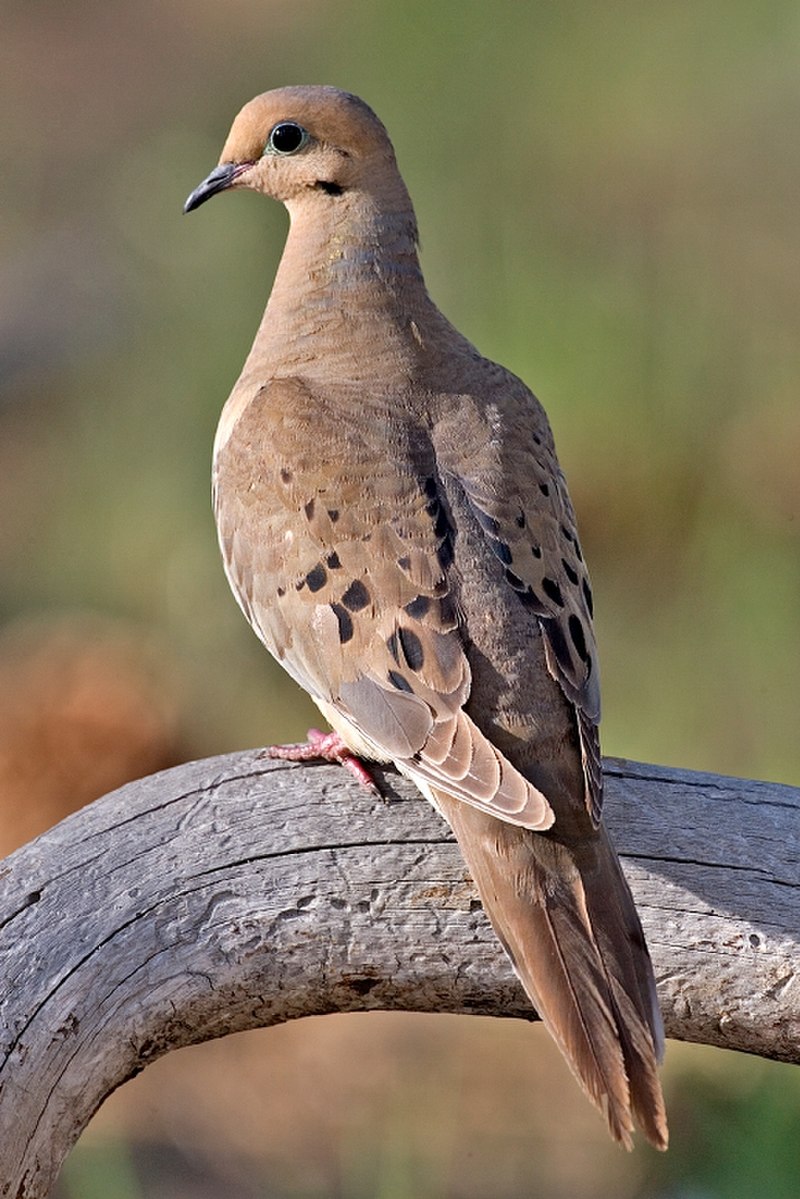
The Mourning Dove is a breathtakingly beautiful bird. It has stunning gray and brown feathers with white tipped wings, giving it an elegant appearance. Its long tail also adds to its graceful look in flight.
A symbol of peace and serenity, they are abundant across North America and can be found in gardens or open fields throughout the year.
As well as being popular game birds for hunters, they feed on grains such as wheat and millet providing important food sources for wildlife species including foxes, coyotes, skunks and raccoons.
These doves have a distinctive cooing sound that can often be heard echoing through woodlands during summer evenings making them one of nature’s greatest treasures.Scientific classification:
| Kingdom | Animalia |
| Phylum | Chordata |
| Class | Aves |
| Order | Columbiformes |
| Family | Columbidae |
| Genus | Zenaida |
| Species | Z. macroura |
Also Featured In: Common Species of Birds, Small Kentucky Birds
20. Tufted Titmouse

The Tufted Titmouse is a small, cheerful songbird found in North America. It’s part of the tit and chickadee family (Paridae).
It has distinctive white feathers around its eyes, grey-brown wings and upper body, with a pale tan underside.
Its most notable feature is the black crest on top of its head that gives it an inquisitive look. The male also sports a pinkish breast which can be seen.
When singing from high perches during the spring months. This bird loves to eat sunflower seeds or suet at backyard feeders as well as insects in summertime.
You may even see them poking into crevices and bark looking for food.
They are quite social birds too, being often spotted in mixed flocks alongside other species such as nuthatches and woodpeckers all year round.Scientific classification:
| Kingdom | Animalia |
| Phylum | Chordata |
| Class | Aves |
| Order | Passeriformes |
| Family | Paridae |
| Genus | Baeolophus |
| Species | B. bicolor |
Also Featured In: Common Birds of Houston, Small Birds that Live in Washington D.C.
21. White-Breasted Nuthatch

The White-breasted Nuthatch is a medium-sized bird belonging to the nuthatch family Sittidae. It measures around 15.5 cm in length and its colour varies throughout its range.
Males have a light blue-grey upperpart, with black crown and nape whereas females have a dark grey crown instead of black one.
The underparts are whitish, with reddish tinge on sides and flanks while the bill is short and stout with pale base near eyes which can be yellow or white depending upon geographic location..
This species feeds mainly on insects but will also eat seeds, nuts and berries when available.
They prefer open woodlands where they often climb trees searching for food along trunks as well as branches underneath bark crevices creating their nest there too.Scientific classification:
| Kingdom | Animalia |
| Phylum | Chordata |
| Class | Aves |
| Order | Passeriformes |
| Family | Sittidae |
| Genus | Sitta |
| Species | S. carolinensis |
Also Featured In: Birds Commonly Found in Northern California, Large Birds Live in Idaho
22. Hummingbirds
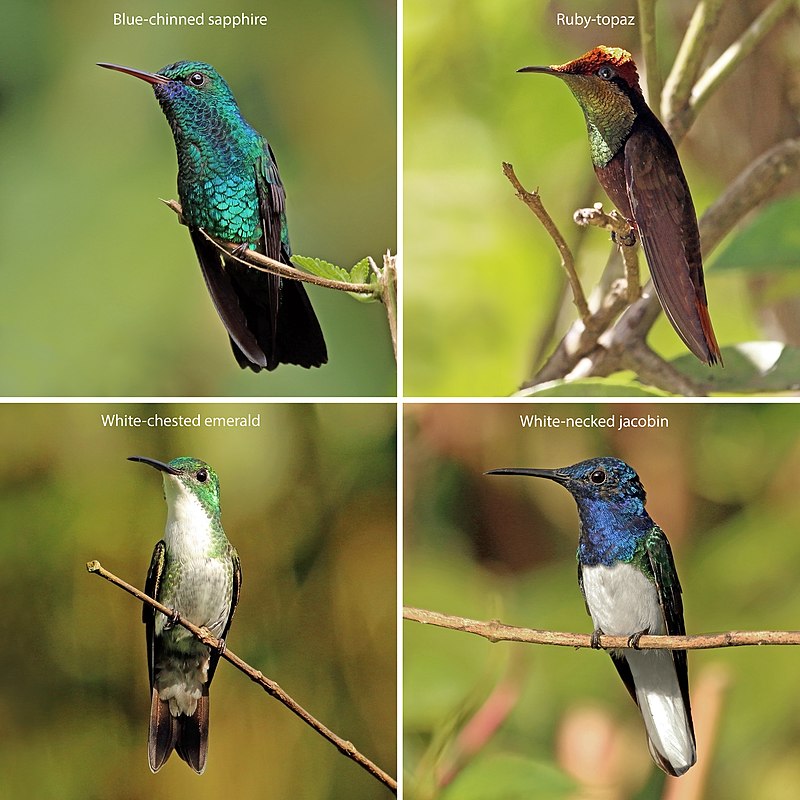
Hummingbirds are tiny birds found throughout the Americas, from Alaska to Tierra del Fuego. Most species measure between 3-5 inches in length and weigh less than an ounce.
The smallest hummingbird is only 2 inches long. Hummingbirds have a unique ability of hovering by rapidly flapping their wings up to 80 times per second.
They feed on nectar and insects, with some species even able to drink sap or eat pollen directly off flowers.
Their vibrant colors make them instantly recognizable as they dart through gardens in search of food and mates.
Hummingbirds truly bring joy into our lives as they remind us that nature’s beauty can be seen around every corner if we take the time to look for it.Scientific classification:
| Kingdom | Animalia |
| Phylum | Chordata |
| Class | Aves |
| Order | Apodiformes |
| Family | Trochilidae Vigors, 1825 |
Also Featured In: Birds that Live in the Deserts, Flight Birds You Should Know
23. Red-Winged Blackbird

The red-winged blackbird is a beautiful bird found in most of North America and Central America.
Its distinct features include a glossy black body, with white shoulder patches and bright red wing coverts year round.
It prefers wetland habitats such as marshes, ponds, lakeshores and agricultural fields. During breeding season they inhabit grassy areas near water then move south for the winter months.
For food they mainly eat insects but also consume wild fruit or grains.
They are very social birds often seen in large flocks during migration times when their unmistakable “conk-la-ree” call can be heard echoing across the sky.Scientific classification:
| Kingdom | Animalia |
| Phylum | Chordata |
| Class | Aves |
| Order | Passeriformes |
| Family | Icteridae |
| Genus | Agelaius |
| Species | A. phoeniceus |
Also Featured In: Wetlands Birds You Should Know, Red birds You’ll See in Arizona
24. Mallard
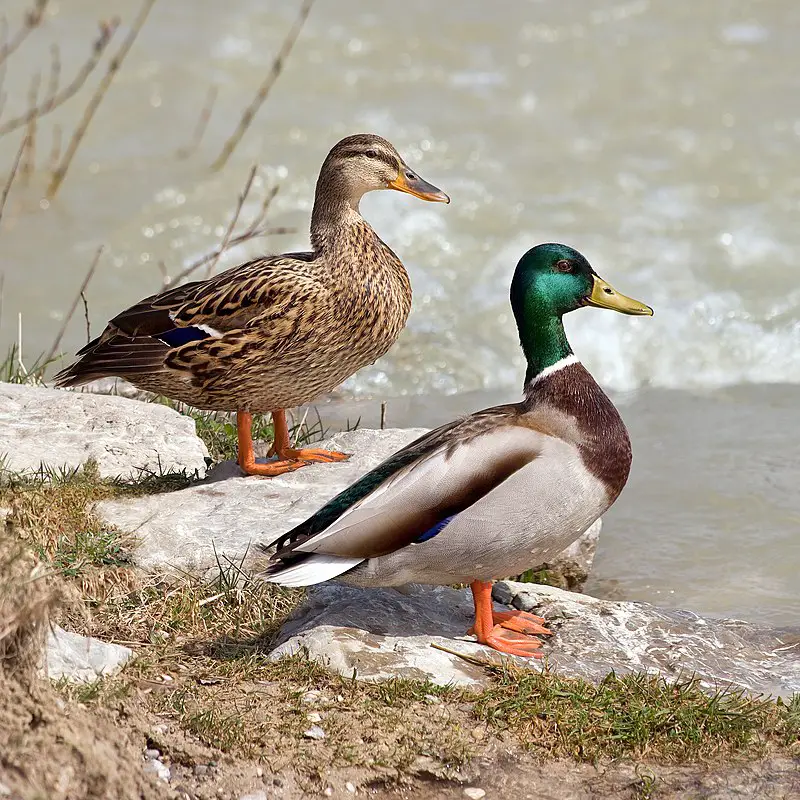
The Mallard is a species of dabbling duck that can be found living in temperate and subtropical regions across the Americas, Eurasia and North Africa.
It has been introduced to other areas such as New Zealand, Australia, Peru, Brazil and South Africa by humans.
This beautiful bird belongs to the Anatinae subfamily of waterfowl family Anatidae. The adult mallards have a glossy green head with white neck ring surrounding.
It along with brownish grey body feathers making them look stunning when they fly away or just sitting in their natural habitat around lakes or ponds.
They are excellent swimmers too due to webbed feet which helps them swim fast underwater while looking for food like aquatic insects etc.. Their loud quacking sound makes them quite popular among nature lovers.Scientific classification:
| Kingdom | Animalia |
| Phylum | Chordata |
| Class | Aves |
| Order | Anseriformes |
| Family | Anatidae |
| Genus | Anas |
| Species | A. platyrhynchos |
Also Featured In: Most Popular Bird Species in North America, Water Birds Live around Us
25. American Woodcock
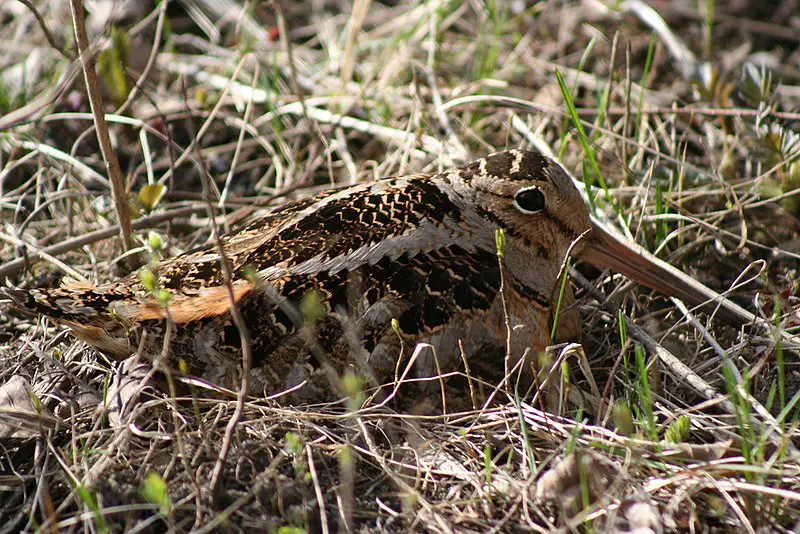
The American woodcock is a small shorebird found mainly in the eastern half of North America. It has brown, black and grey plumage which helps it blend into its brushy, young-forest habitats perfectly.
Often referred to as the timberdoodle or bogsucker due to its quirky behavior, these birds are normally solitary and spend their time foraging on the ground for food like worms and insects.
During mating season males perform an elaborate courtship ritual involving loud calls from atop tall perches followed by graceful dives towards earth while singing songs along the way.
The female then selects her mate based solely upon his performance during this ritual display.
All in all, this bird is truly amazing with both a unique appearance and interesting behaviors that have made them quite popular amongst ornithologists around the world.Scientific classification:
| Kingdom | Animalia |
| Phylum | Chordata |
| Class | Aves |
| Order | Charadriiformes |
| Family | Scolopacidae |
| Genus | Scolopax |
| Species | S. minor |
Also Featured In: Small Birds Live in Vermont, Large Birds that Live in Vermont
26. Brown-Headed Cowbird
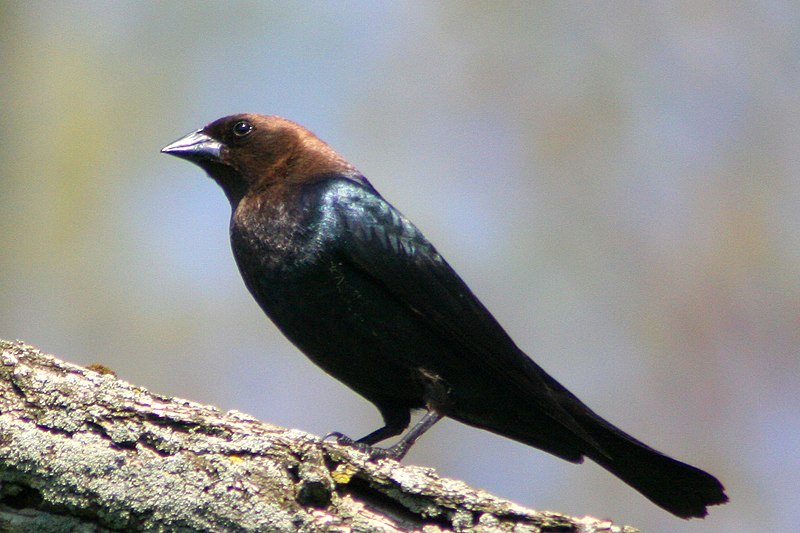
The Brown-headed Cowbird is a small, obligate brood parasitic icterid native to temperate and subtropical North America. It has a brown head with glossy black plumage on the body, wings and tail feathers.
During summer months it can be found in prairies, grasslands as well as open wooded areas but during winter they migrate southwards towards the United States of Mexico for warmer climate.
They are mainly insectivorous birds which feed on insects like caterpillars or beetles but also consume some grains too.
The female bird lays its eggs in nests of other species who then incubates them until hatching time thus leaving their own chicks uncared for by themselves.Scientific classification:
| Kingdom | Animalia |
| Phylum | Chordata |
| Class | Aves |
| Order | Passeriformes |
| Family | Icteridae |
| Genus | Molothrus |
| Species | M. ater |
Also Featured In: Birds You’ll Find in Vancouver Island, Brown Birds that Live in West Virginia
27. Barn Swallow
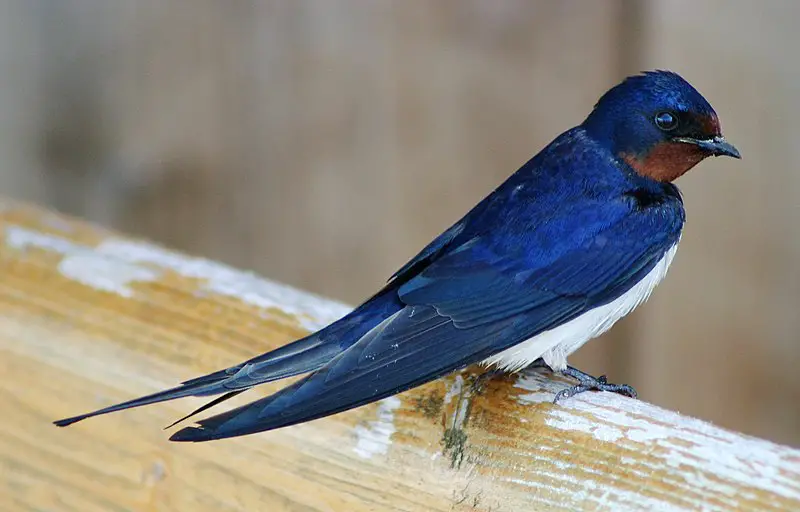
The Barn Swallow is a beautiful passerine bird with blue upperparts and a long, deeply forked tail. Found in Europe, Asia, Africa and the Americas.
It has an astonishingly large natural distribution spanning 251 million square kilometres globally; likely making it one of the world’s most widespread species.
This swallow typically nests near human habitation as well as other open areas such as fields or grasslands which provide them with suitable invertebrate prey to feed on.
They are insectivorous birds that often fly together in flocks looking for food over rivers or marshes usually just above tree-top level.
The barn swallow can also be identified by its strong flight consisting of swift continuous wing beats interspersed with glides during which they hold their wings slightly raised at the shoulders giving them distinct V shaped silhouettes in the sky.Scientific classification:
| Kingdom | Animalia |
| Phylum | Chordata |
| Class | Aves |
| Order | Passeriformes |
| Family | Hirundinidae |
| Genus | Hirundo |
| Species | H. rustica |
Also Featured In: Birds that Live in Croatia, Common Estonian Birds
28. Canada Goose
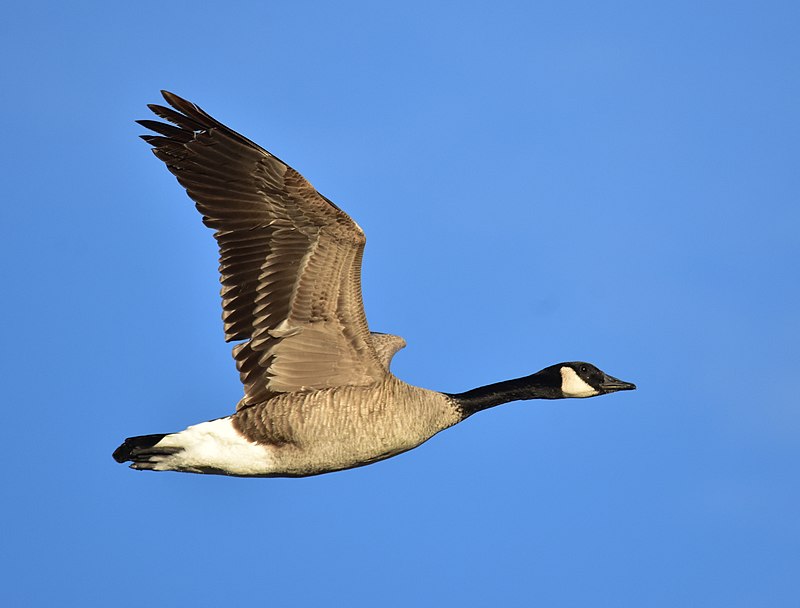
The Canada goose is a majestic bird with a black head and neck, white cheeks, chin and brown body. It’s native to North America but occasionally migrates to northern Europe across the Atlantic.
The species has been introduced in the United Kingdom, Ireland and Finland as well. Canada geese are strong flyers that travel in flocks for protection from predators; they also form monogamous pairs for life.
They feed on grasses or grains near ponds or wetlands where they make their nests of down which incubate eggs during summertime before hatching them out into goslings later on.Scientific classification:
| Kingdom | Animalia |
| Phylum | Chordata |
| Class | Aves |
| Order | Anseriformes |
| Family | Anatidae |
| Genus | Branta |
| Species | B. canadensis |
Also Featured In: Most Common Lake Birds, Birds that Commonly Found in Pond
29. Common Grackle

The Common Grackle is a large icterid bird commonly found in North America. It has an iridescent head and pale yellow eyes, which are framed by its long dark bill and long tail.
Males typically have more vivid colors on their heads than females do. These birds can be seen across much of the continent, in fields, forests, wetlands – even urban areas.
They form huge flocks to search for food such as grains or insects that they catch with their bills.
The grackles may also scavenge from human sources like garbage dumps or picnic tables if available. With its colorful plumage and distinct call it’s easy to spot this species amongst other birds.Scientific classification:
| Kingdom | Animalia |
| Phylum | Chordata |
| Class | Aves |
| Order | Passeriformes |
| Family | Icteridae |
| Genus | Quiscalus |
| Species | Q. quiscula |
Also Featured In: Central Texas Birds, Birds that Live around Central Florida
30. Killdeer
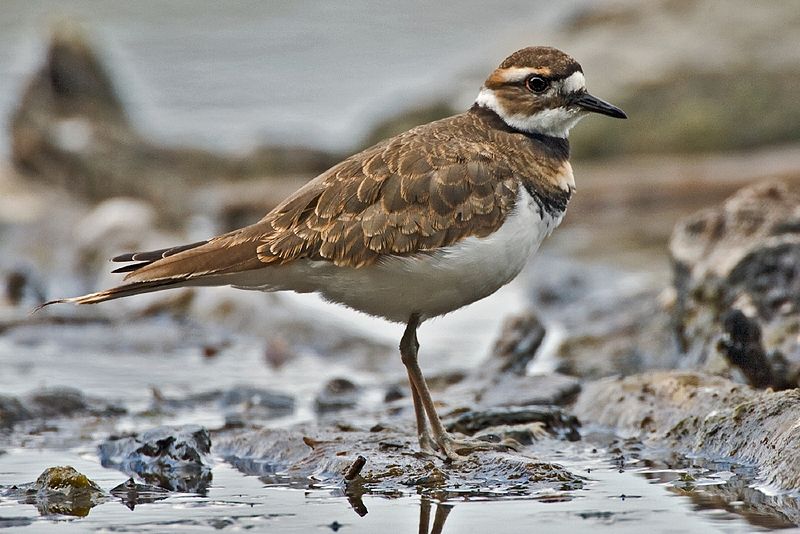
The Killdeer bird is a large plover found in the Americas. It has an unmistakable call which gives it its name, and boasts striking upperparts of brown with rufous fringes.
Its head features patches of white and black, while two distinctive bands adorn its neck – one black above, and one chestnut below.
The undersides are mostly white or pale buff-brown; their wings feature bright orange stripes when they take flight.
During breeding season males perform elaborate courtship rituals to attract females into establishing a pair bond; they also defend territories fiercely against other birds that encroach on them during this time.
In winter months some killdeers migrate southwards but many stay put throughout the cold weather too.
All in all these beautiful creatures provide us with quite a sight indeed.Scientific classification:
| Kingdom | Animalia |
| Phylum | Chordata |
| Class | Aves |
| Order | Charadriiformes |
| Family | Charadriidae |
| Genus | Charadrius |
| Species | C. vociferus |
Also Featured In: Birds You’ll Find in South Texas , Birds in Pacific Northwest
31. Finches
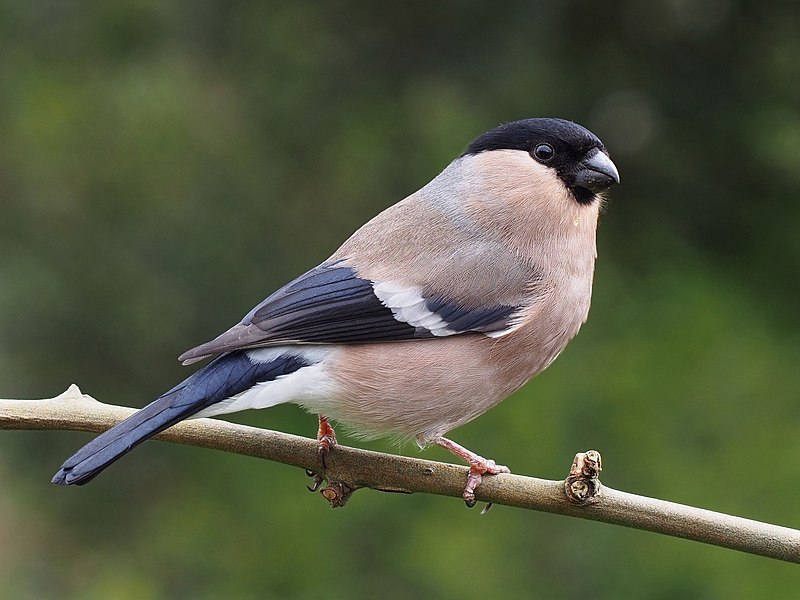
Finches are a diverse group of passerine birds found around the world, excluding Australia and polar regions. They vary in size from small to medium-sized, with stout conical bills adapted for eating seeds and nuts.
Many species have brightly coloured plumage; this helps them stand out against their natural habitats which can range from deserts to forests.
Finches occupy these areas all year round without migrating elsewhere – making them particularly well suited for local environments.
As part of the Fringillidae family they possess unique characteristics that make them popular amongst birdwatchers everywhere.Scientific classification:
| Kingdom | Animalia |
| Phylum | Chordata |
| Class | Aves |
| Order | Passeriformes |
| Superfamily | Passeroidea |
| Family | Fringillidae Leach, 1820 |
Also Featured In: Native Pakistani Birds, Aviary Birds You Should Know
32. Woodpeckers
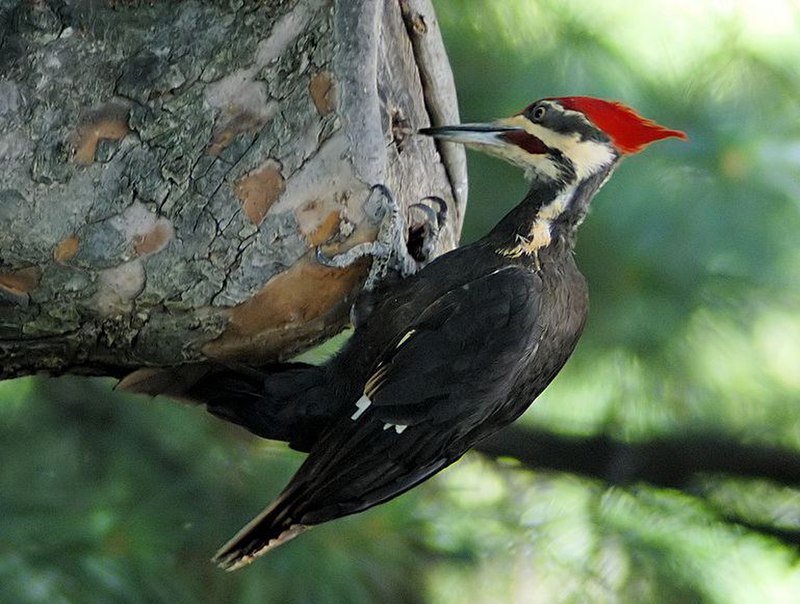
Woodpeckers are an incredibly diverse bird species, found all over the world except for Australia, New Guinea, New Zealand, Madagascar and the extreme polar regions.
They live in a variety of habitats including forests and woodlands but also rocky hillsides and deserts with no trees.
Their beaks are adapted to pecking at tree bark to find food such as insects or larvae hidden beneath it while they use their long tongues to catch them from deep inside crevices.
Woodpeckers have tough skulls that protect their brains from impact when they bang into things during drumming – a behaviour used by males for territorial signalling and reproduction purposes which is done using strong rapid beats against hollow objects like dead branches or metal poles.Scientific classification:
| Kingdom | Animalia |
| Phylum | Chordata |
| Class | Aves |
| Order | Piciformes |
| Infraorder | Picides |
| Family | Picidae Leach, 1820 |
Also Featured In: Most Common Types of Bangladeshi Birds, Common Serbian Birds
33. Lesser Goldfinch
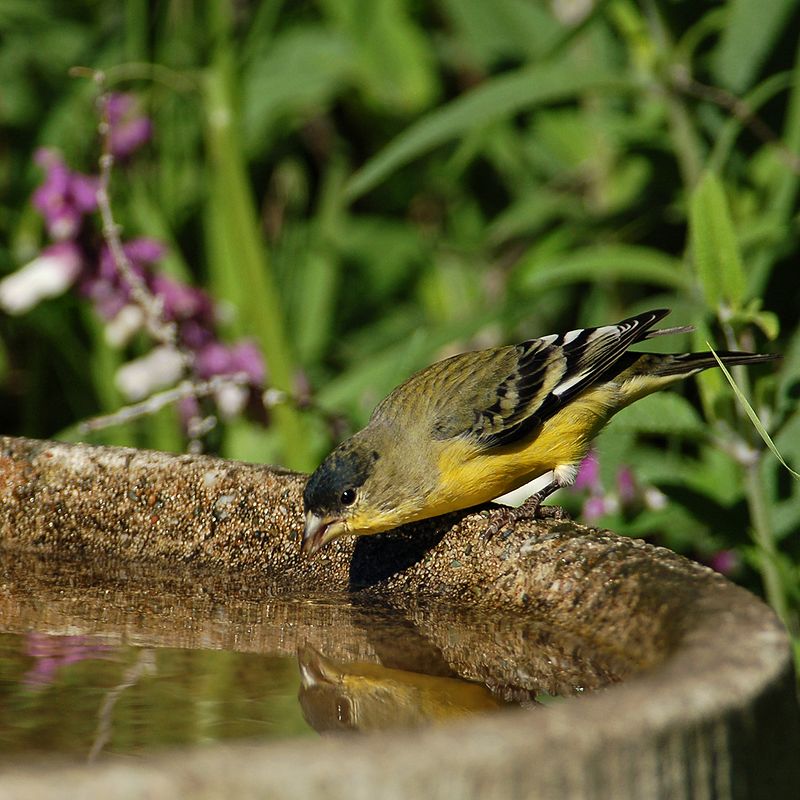
The Lesser Goldfinch is a tiny species of bird found in the Americas. It belongs to the same clade as American goldfinches and Lawrence’s goldfinches, which can be identified by their males having black or rarely green foreheads.
The face appears red or yellow on these birds unlike other species in its genus Spinus sensu stricto.
They are small songbirds with short bills, brown wings and tails with white edges, grey-brown backs and olive heads.
These birds inhabit open woodlands and fields where they feed mainly on seeds from weeds such as thistle, pigweed and ragweed but also consume insects at times during breeding season for additional nutrition.
In addition to being an important part of North America’s avian ecology, these birds have been popularized through recent artwork depicting them in various poses among flowers.Scientific classification:
| Kingdom | Animalia |
| Phylum | Chordata |
| Class | Aves |
| Order | Passeriformes |
| Family | Fringillidae |
| Subfamily | Carduelinae |
| Genus | Spinus |
| Species | S. psaltria |
Also Featured In: Top Birds Found in Mexico, Birds that Live in Yosemite National Park
34. Swallows
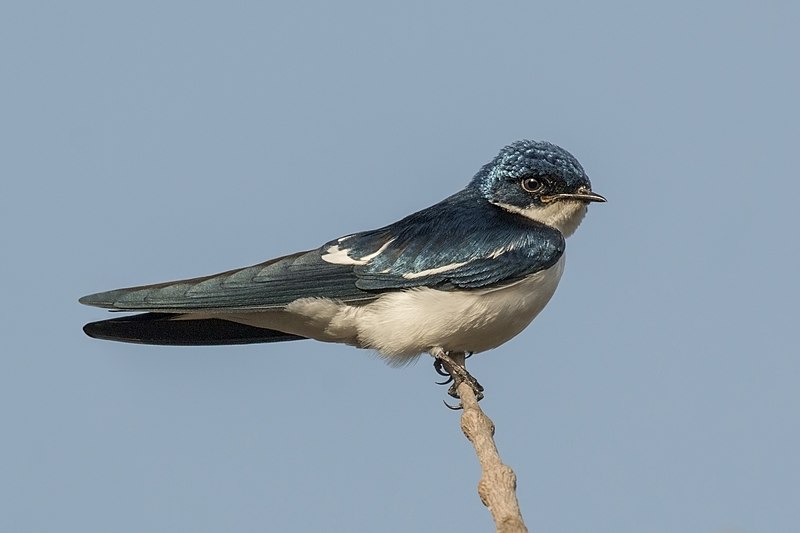
Swallows are small songbirds found around the world on all continents, even Antarctica. They have a distinctive appearance and are highly adapted to aerial feeding with their long wings and forked tail.
There is an estimated 90 species of swallows in 19 different genera, making them one of the most widespread bird families on earth.
The barn swallow is perhaps the most well-known species among these birds due to its presence near human settlements across Europe; they’re so ubiquitous that “swallow” has become synonymous with this particular type of bird there.
Swallows also play important roles in ecology as insectivores; some species migrating vast distances every year between summer breeding grounds and wintering locations.Scientific classification:
| Kingdom | Animalia |
| Phylum | Chordata |
| Class | Aves |
| Order | Passeriformes |
| Suborder | Passeri |
| Family | Hirundinidae Rafinesque, 1815 |
Also Featured In: Birds of United Kingdom, Birds that are Used in Feng Shui
35. Tit
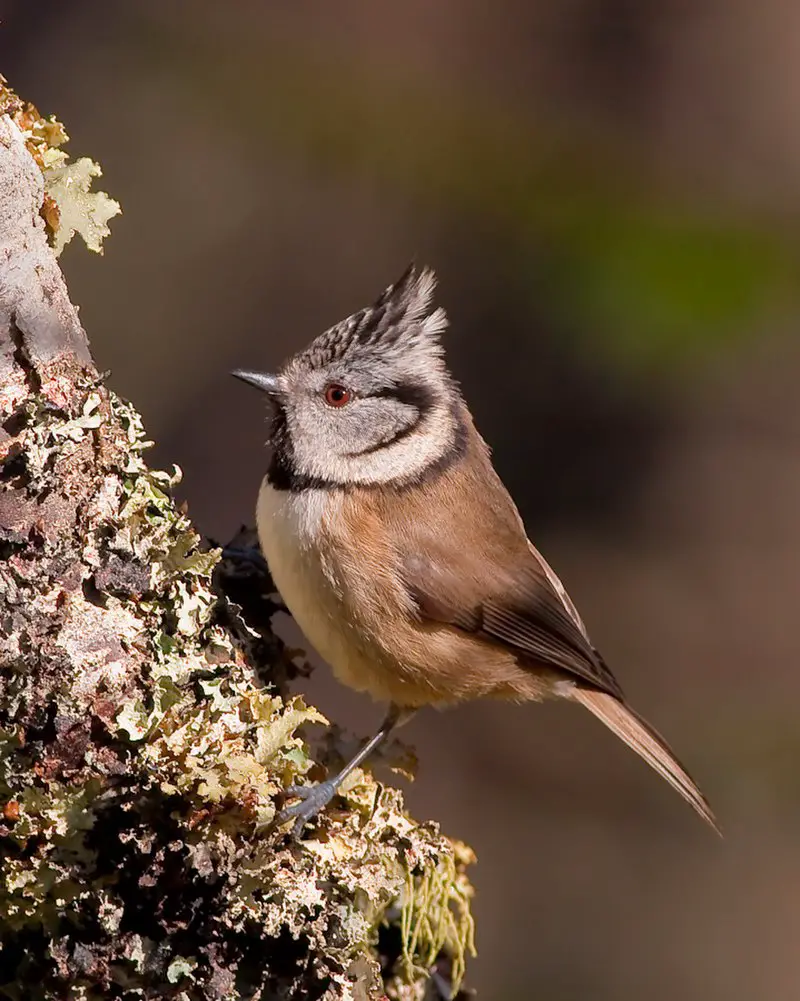
Tit birds are small passerine birds belonging to the family Paridae, found mainly in Northern Hemisphere and Africa.
These active little birds can be seen singing sweet songs throughout the day or scavenging for food at feeders.
They have short, stout bills which they use to crack open seeds and nuts with ease. Tit species range from chickadees to titmice; all of them sport a distinctive black head cap that stands out against their pale grey bodies.
Their bright eyes allow them excellent vision while searching for food – even on gloomy days when other predators may not see as well.
Tits are an important part of any healthy ecosystem and provide many ecological services such as insect control and seed dispersal.Scientific classification:
| Kingdom | Animalia |
| Phylum | Chordata |
| Class | Aves |
| Order | Passeriformes |
| Infraorder | Passerida |
| Family | Paridae Vigors, 1825 |
Also Featured In: Willows Birds Around You, Turkey Birds You Should Know
36. Cardinal
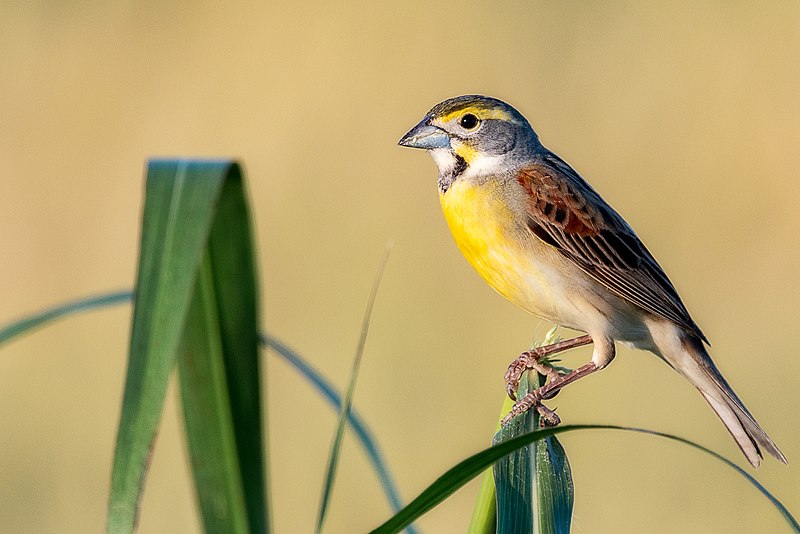
Cardinalidae is a family of passerine birds endemic to the New World that includes cardinals, grosbeaks and buntings.
This large group has great diversity in its members which range from tanager-like Piranga to warbler-like Granatellus.
They are usually distinguished by their bright plumage with reds, oranges and yellows being common among them.
Their strong bills enable them to feed on seeds, fruits and insects as well as other small prey items like lizards or frogs depending upon species.
Cardinals also have loud calls often used for territorial defense and courtship purposes while some can even imitate sounds made by other animals.
These adaptable birds inhabit a variety of habitats across North America making them an important part of many ecosystems there.Scientific classification:
| Kingdom | Animalia |
| Phylum | Chordata |
| Class | Aves |
| Order | Passeriformes |
| Superfamily | Emberizoidea |
| Family | Cardinalidae Ridgway, 1901 |
Also Featured In: Common Birds in Canada, Spiritual Birds
37. Icterids
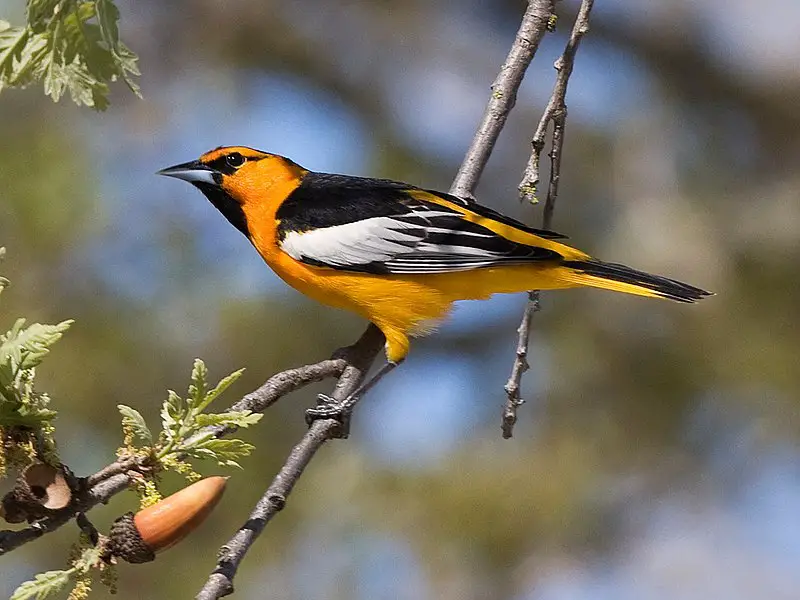
Icterids are a family of small to medium-sized, often colorful New World passerine birds. They have black as their predominant plumage color with yellow, orange or red adding vibrancy and life.
Their sizes range greatly in shape and behavior making them unique amongst other bird species.
The name Icterid comes from the Latin word ‘ictericus’ which means jaundiced ones – referring to the prominent yellow coloring found on some of these birds’ feathers.
These beautiful creatures can be seen flying around many different parts of South America where they live with their young for most part of the year before migrating northwards during fall season.Scientific classification:
| Kingdom | Animalia |
| Phylum | Chordata |
| Class | Aves |
| Order | Passeriformes |
| Superfamily | Emberizoidea |
| Family | Icteridae Vigors, 1825 |
Also Featured In: British Virgin Islands Birds You Need to See, Yellow Ontario Birds
38. Song Sparrow

The Song Sparrow (Melospiza melodia) is a small, yet abundant bird found in North America.
They have brown upperparts with dark streaks and are white underneath, complete with a distinct dark brown spot on the breast.
Their cap is also brown and long roughed feathers can be seen sprouting from their neck area.
This sparrow species is highly variable and adaptable to many different environments including dry brush land, wetlands or open fields.
It has been noted that adult song sparrows will sing even during winter months when other birds remain quiet.
These energetic little animals make for great backyard companions as they flit about singing their lovely melodies.Scientific classification:
| Kingdom | Animalia |
| Phylum | Chordata |
| Class | Aves |
| Order | Passeriformes |
| Family | Passerellidae |
| Genus | Melospiza |
| Species | M. melodia |
Also Featured In: Brown Birds that are Found in Mississippi, Brown Tennessee Birds
39. Great Kiskadee
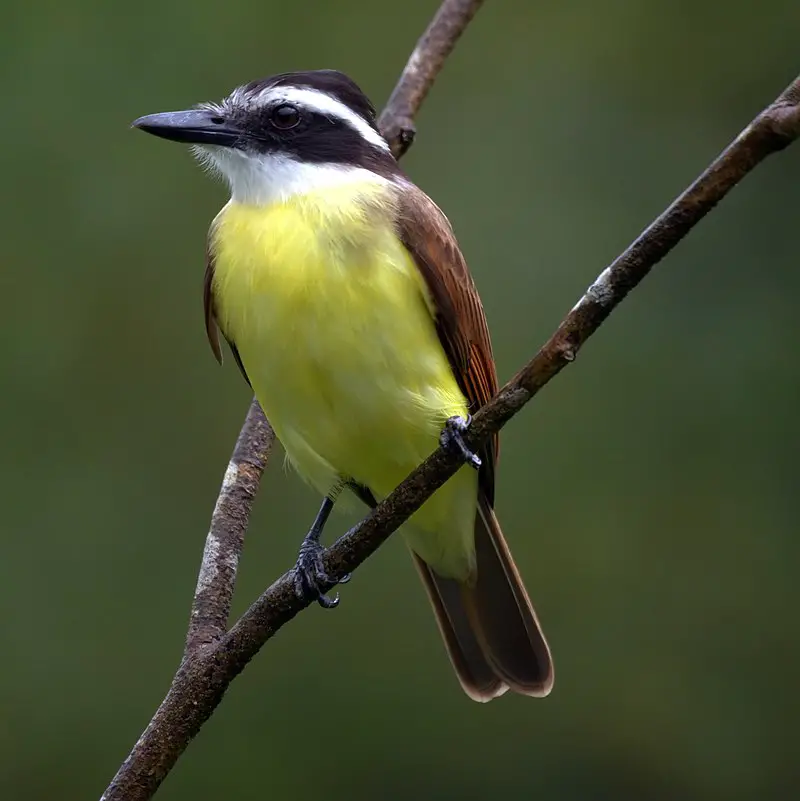
The Great Kiskadee is a passerine bird belonging to the Tyrant Flycatcher family.
It has an unmistakable yellow and black plumage, making it easily recognizable in its native habitats of Belize, Texas, Argentina and Brazil where it is known as Bem-te-vi or Benteveo respectively.
The species inhabits open woodland with some tall trees such as cultivation areas and other places surrounding human dwellings.
This adaptable bird feeds mainly on insects but also consumes fruit for energy when needed.
Its call resembles laughter which adds to its charm among avid nature watchers who are always delighted by their presence.
A unique feature that sets this species apart from others is that they can imitate songs of other birds accurately too.Scientific classification:
| Kingdom | Animalia |
| Phylum | Chordata |
| Class | Aves |
| Order | Passeriformes |
| Family | Tyrannidae |
| Genus | Pitangus Swainson, 1827 |
| Species | P. sulphuratus |
Also Featured In: Most Common Birds In Paraguay, Most Common Birds in South America Birds
40. Blue Grosbeak
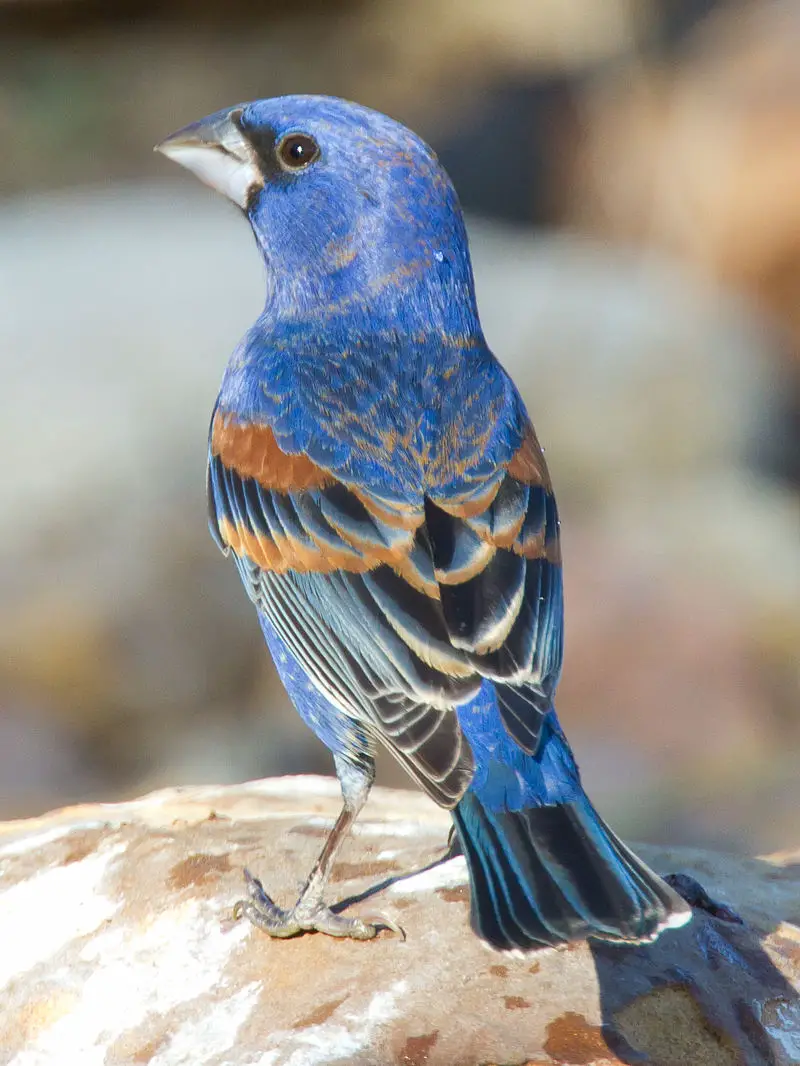
The Blue Grosbeak is a medium-sized North American passerine bird from the Cardinalidae family. It has striking plumage, with males showing off an impressive blue coloration and two brown wing bars.
Females are mainly brown with scattered blue feathers on the upperparts, but they also have two brown wing bars like males do.
During summer months these birds can be found in northern Mexico and southern United States where they breed, while during wintertime it migrates to Central America for resting purposes.
This beautiful species of bird is easy to spot due its vibrant colors making it a popular sight amongst wildlife observers.Scientific classification:
| Kingdom | Animalia |
| Phylum | Chordata |
| Class | Aves |
| Order | Passeriformes |
| Family | Cardinalidae |
| Genus | Passerina |
| Species | P. caerulea |
Also Featured In: El Salvador Birds, Birds that Live around Santiago de Querétaro
41. Ruby-Throated Hummingbird

The ruby-throated hummingbird (Archilochus colubris) is a species of hummingbird that has an impressive migration pattern, spending the winter in Central America, Mexico and Florida before flying to Canada and other parts of Eastern North America for breeding season.
It’s by far the most common type seen east of the Mississippi River in North America.
Formally described by Swedish naturalist Carl Linnaeus in 1758, this tiny bird has bright metallic green upperparts with white underparts, a small black bill and a red throat patch which gives it its name; they measure around 3 inches long on average.
They feed primarily on nectar from flowers but also eat insects such as flies or mosquitoes for extra protein during their migrations or when raising young chicks.Scientific classification:
| Kingdom | Animalia |
| Phylum | Chordata |
| Class | Aves |
| Order | Apodiformes |
| Family | Trochilidae |
| Genus | Archilochus |
| Species | A. colubris |
Also Featured In: Georgia Birds, Red Birds You’ll See in Oklahoma
42. Eastern Phoebe
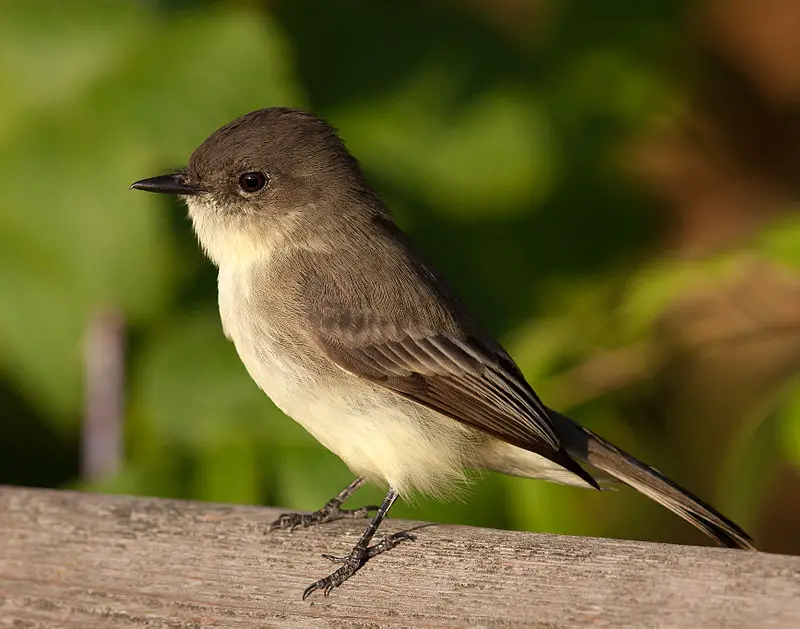
The Eastern Phoebe is a small passerine bird belonging to the genus Sayornis. It gets its name from Charles Lucien Bonaparte’s Muscicapa saya, and Ancient Greek ornis meaning “bird”.
The species’ alternative name ‘Phoebe’ comes from the Roman moon-goddess Diana, but also has been said to imitate their call.
Measuring up to 16 cm in length with a wingspan of 25–30 cm, they have grayish brown upperparts and pale underparts.
They are found near streams, woodlands and open fields where they hunt for insects such as flies, bees wasps etc., often catching them midair or by sallying out from perchs like branches or fences.
These birds make shallow cup nests made of grasses lined with mud which are built on cliffs ledges walls buildings bridges trees etc..
All in all this beautiful little bird is an interesting addition wherever you find it.Scientific classification:
| Kingdom | Animalia |
| Phylum | Chordata |
| Class | Aves |
| Order | Passeriformes |
| Family | Tyrannidae |
| Genus | Sayornis |
| Species | S. phoebe |
Also Featured In: Birds that Make Mud Nests, Common Vermont Winter Birds
43. Scarlet Tanager

The Scarlet Tanager is a beautiful medium-sized bird found in parts of North and South America. It belongs to the Cardinal family, and has striking red plumage with black wings and tail feathers.
Its song is similar to other cardinals yet also unique in its own way – it’s recognizable by its high whistles that become lower towards the end.
The species feeds mainly on insects as well as berries from trees or shrubs during breeding season, when they may form loose flocks over open woodlands foraging for food.
They are highly territorial birds during nesting season which happens between April and June each year; both males and females fiercely defend their nests against intruders such as cats or squirrels.Scientific classification:
| Kingdom | Animalia |
| Phylum | Chordata |
| Class | Aves |
| Order | Passeriformes |
| Family | Cardinalidae |
| Genus | Piranga |
| Species | P. olivacea |
Also Featured In: Yellow Connecticut Birds, Common Yellow Birds of Idaho
44. Eastern Kingbird
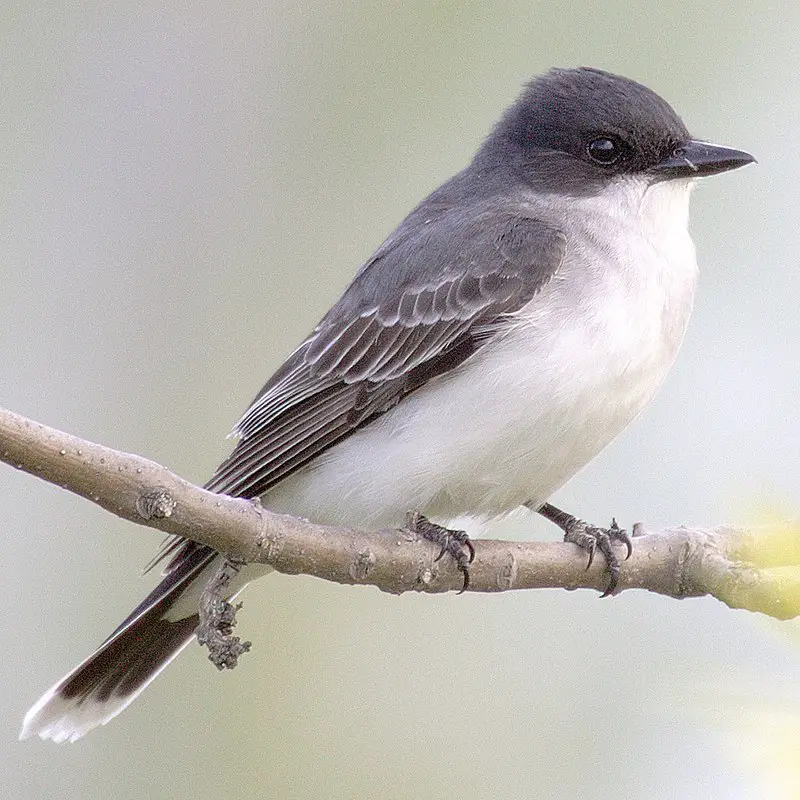
The Eastern kingbird is an impressive large grey bird, with a white underbelly and pointed wings. It can be seen perched atop trees or bushes in open areas while foraging for insects.
This species of tyrant flycatcher breeds across much of North America during the spring and summer months before migrating southwards come wintertime.
During this time, they have been known to travel as far south as Central and South America.
These birds are particularly territorial when nesting; having been observed chasing off even larger animals such as hawks away from their nests. A truly remarkable sight to behold.Scientific classification:
| Kingdom | Animalia |
| Phylum | Chordata |
| Class | Aves |
| Order | Passeriformes |
| Family | Tyrannidae |
| Genus | Tyrannus |
| Species | T. tyrannus |
Also Featured In: Flycatchers Species, Birds that You’ll Find in Puerto Rico
45. Nuttall’s Woodpecker
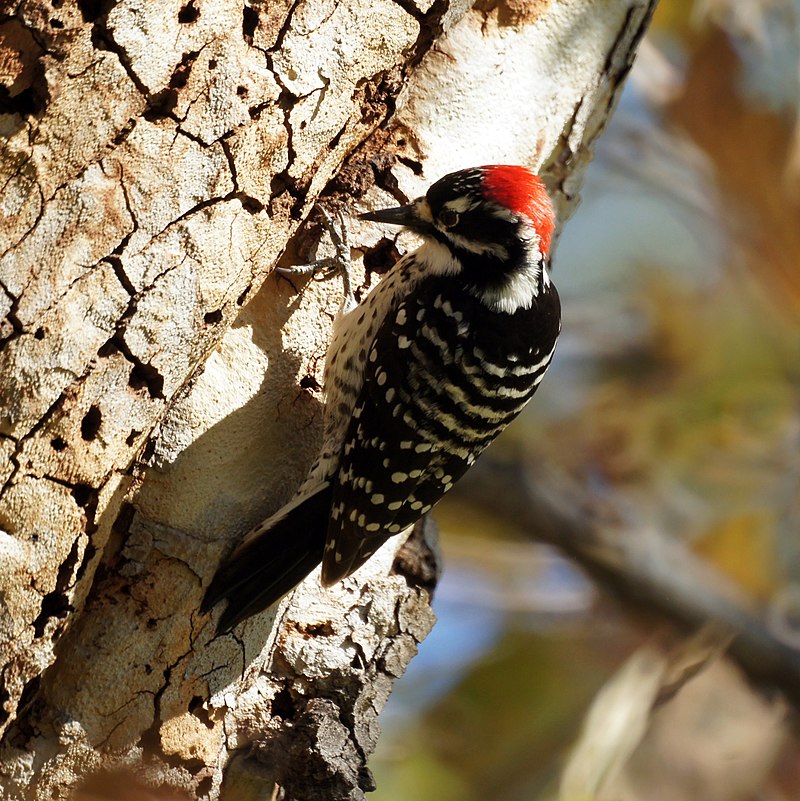
Nuttall’s woodpecker is a species of woodpecker named after naturalist Thomas Nuttall in 1843.
It is found mainly in oak woodlands of California and resembles the ladder-backed woodpecker genetically and physically.
The bird has black wings and tail feathers with white barring, as well as a white ventral surface decorated by small black spots.
They are quite distinct from other species due to their unique colouring; they have been known to hybridize successfully with red-naped sapsuckers when their habitats overlap.
While not considered threatened or endangered, these birds must be monitored closely to ensure that populations remain healthy across their range.Scientific classification:
| Kingdom | Animalia |
| Phylum | Chordata |
| Class | Aves |
| Order | Piciformes |
| Family | Picidae |
| Genus | Dryobates |
| Species | D. nuttallii |
Also Featured In: Woodpeckers Species, Birds Live Near San Diego
46. Painted Bunting
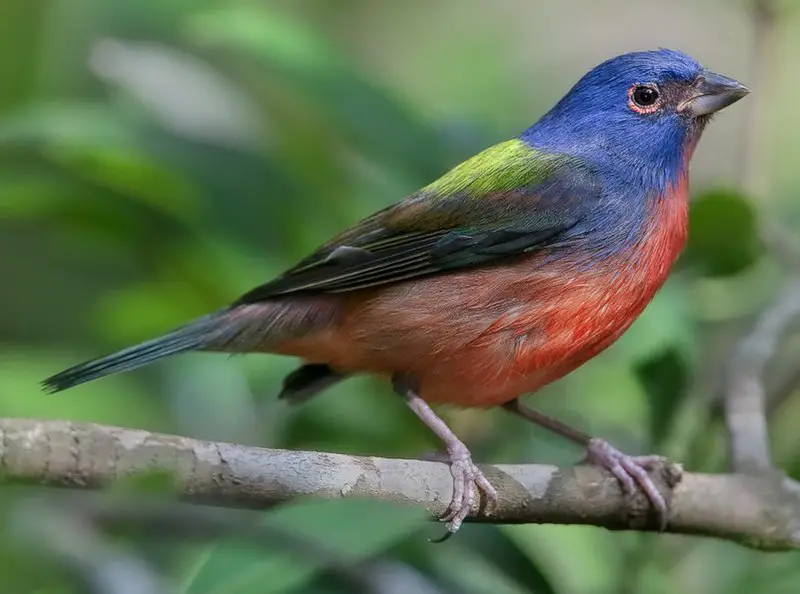
The Painted Bunting is an eye-catching bird from the Cardinal family, native to North America. It was first described by Carl Linnaeus in his eighteenth-century Systema Naturae.
The males of this species are particularly striking; they have brightly coloured plumage which only appears after their second year of life and can be distinguished from female birds through close inspection.
These colourful songbirds are a delight for any avid birder, with their vibrant hues bringing joy to nature lovers everywhere.
They often inhabit woodland areas where there is plenty of seed and insects available for them to feed on – as well as some shrubbery so that they can hide away safely when needed.Scientific classification:
| Kingdom | Animalia |
| Phylum | Chordata |
| Class | Aves |
| Order | Passeriformes |
| Family | Cardinalidae |
| Genus | Passerina |
| Species | P. ciris |
Also Featured In: Texas Birds, Flocks Birds around Us
47. Western Tanager
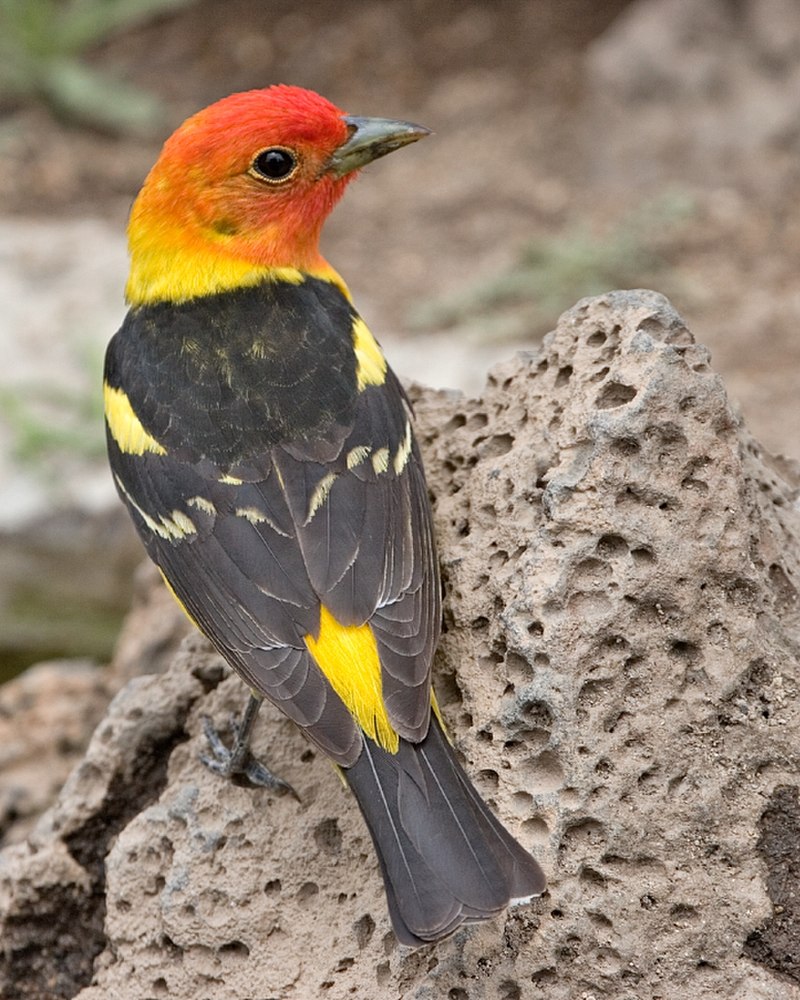
The Western Tanager (Piranga ludoviciana) is a medium-sized songbird belonging to the cardinal family, Cardinalidae. It was illustrated and formally described by American ornithologist Alexander Wilson in 1811.
The species has distinctive plumage including yellow feathers on its wings and tail, red shoulders, black head with white forehead patch and grayish underparts.
Its vocalizations are also very similar to other members of the cardinal family – they have a high pitched ‘tsee’ note followed by several sweeter notes that come together as parts of complex songs.
They primarily feed on fruit but will also take insects when available for extra protein during breeding season.
These beautiful birds can be found throughout western North America from Alaska down through Mexico making them an iconic part of many landscapes.Scientific classification:
| Kingdom | Animalia |
| Phylum | Chordata |
| Class | Aves |
| Order | Passeriformes |
| Family | Cardinalidae |
| Genus | Piranga |
| Species | P. ludoviciana |
Also Featured In: Utah Birds, Birds that Found in the Yellowstone
48. Old World Sparrows
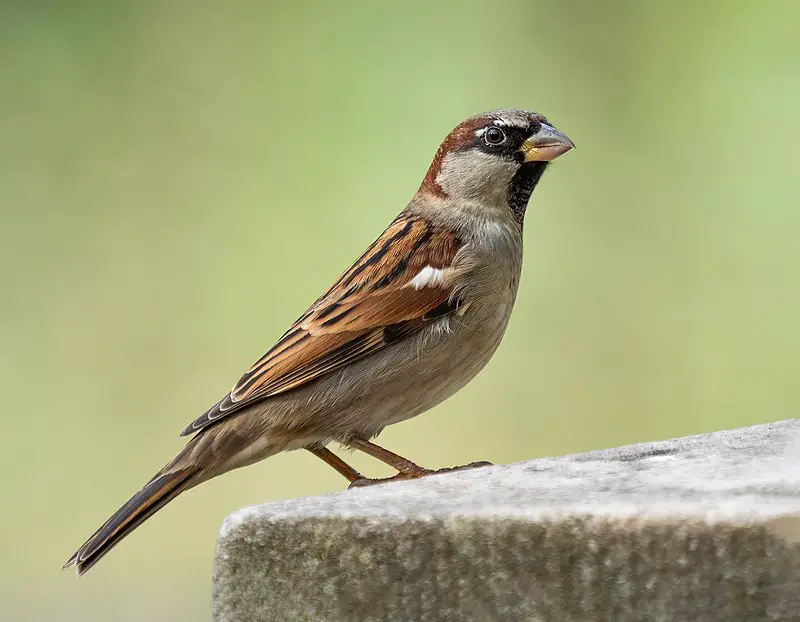
Old World sparrows are small passerine birds belonging to the family Passeridae. They are characteristically much smaller than their New World counterparts, ranging in size from 6 centimeters up to 20 centimeters depending on species.
The most common characteristics of these birds include a black or grey head and upper body with white underparts and white stripes above their eyes.
Notable features such as barring and streaking can be found across different species within this group.
Old world sparrows typically inhabit open grassland areas but have been known to nest around human dwellings near urban settings as well, making them easily recognizable by many people all over the globe.Scientific classification:
| Kingdom | Animalia |
| Phylum | Chordata |
| Class | Aves |
| Order | Passeriformes |
| Suborder | Passeri |
| Infraorder | Passerida |
| Superfamily | Passeroidea |
| Family | Passeridae Rafinesque, 1815 |
Also Featured In: Alaska Birds, Most Common Winter Birds
49. Red-Winged Blackbirds
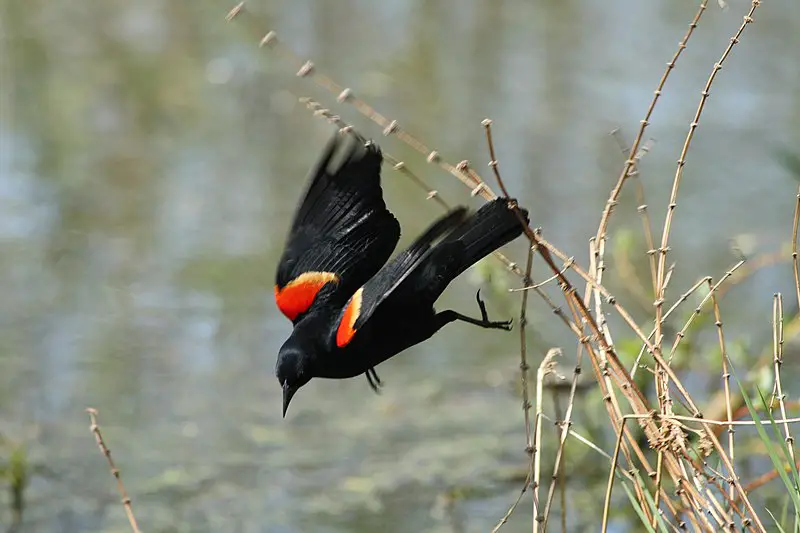
The Red-winged Blackbird (Agelaius phoeniceus) is a species of blackbird found throughout North and South America.
This bird has distinctive red, yellow, and brown plumage on its wings which make it easily identifiable in the wild.
The male’s bright colors are used for territorial display during breeding season when they gather together in large colonies to breed.
They feed mainly on insects such as grasshoppers, beetles, flies as well as grains from fields or yards where available.
These birds also have a loud melodic call that can be heard over long distances; making them one of the most common songbirds across their range.Scientific classification:
| Kingdom | Animalia |
| Phylum | Chordata |
| Class | Aves |
| Order | Passeriformes |
| Family | Icteridae |
| Genus | Agelaius Vieillot, 1816 |
Also Featured In: birds of black,
50. European Robin
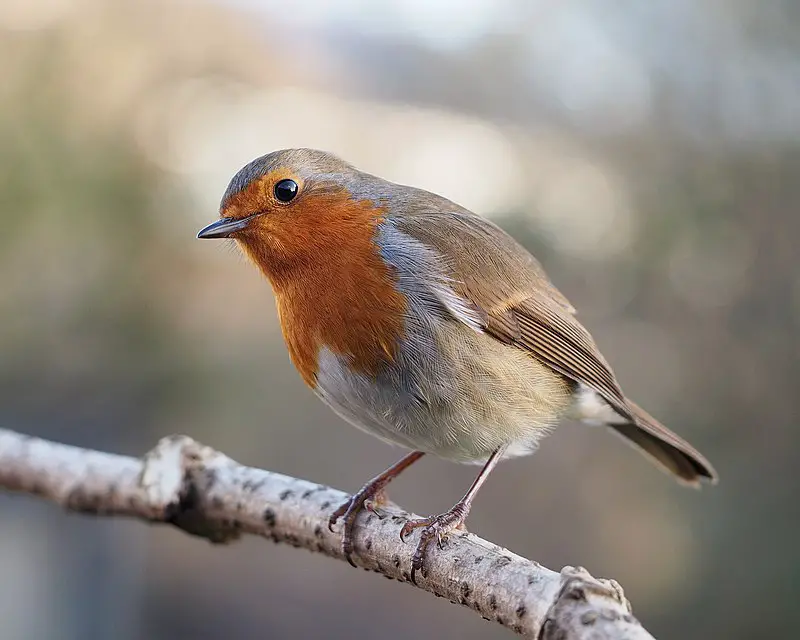
The European robin, also known as simply robin or robin redbreast, is a small insect-eating bird belonging to the chat subfamily.
This bird species can be found across Europe, extending east to Western Siberia while inhabiting North Africa.
The bird species is relatively sedentary and is found in most of its range, except for the far north.
Measuring around 12.5-14.0 cm, this bird is commonly known for its distinctively red breast feathers.
As an insectivorous passerine bird, the European robin mainly feeds on insects to sustain its energy.
Given its widespread range throughout Europe and continuous presence in certain parts of the world, the European robin is widely recognized for its distinct physical appearance, singsong voice, and tiny size.Scientific classification:
| Kingdom | Animalia |
| Phylum | Chordata |
| Class | Aves |
| Order | Passeriformes |
| Family | Muscicapidae |
| Genus | Erithacus |
| Species | E. rubecula |
Also Featured In: Most Common Songs Birds that Live around You, Italian Birds You Should Know
51. Cedar Waxwing
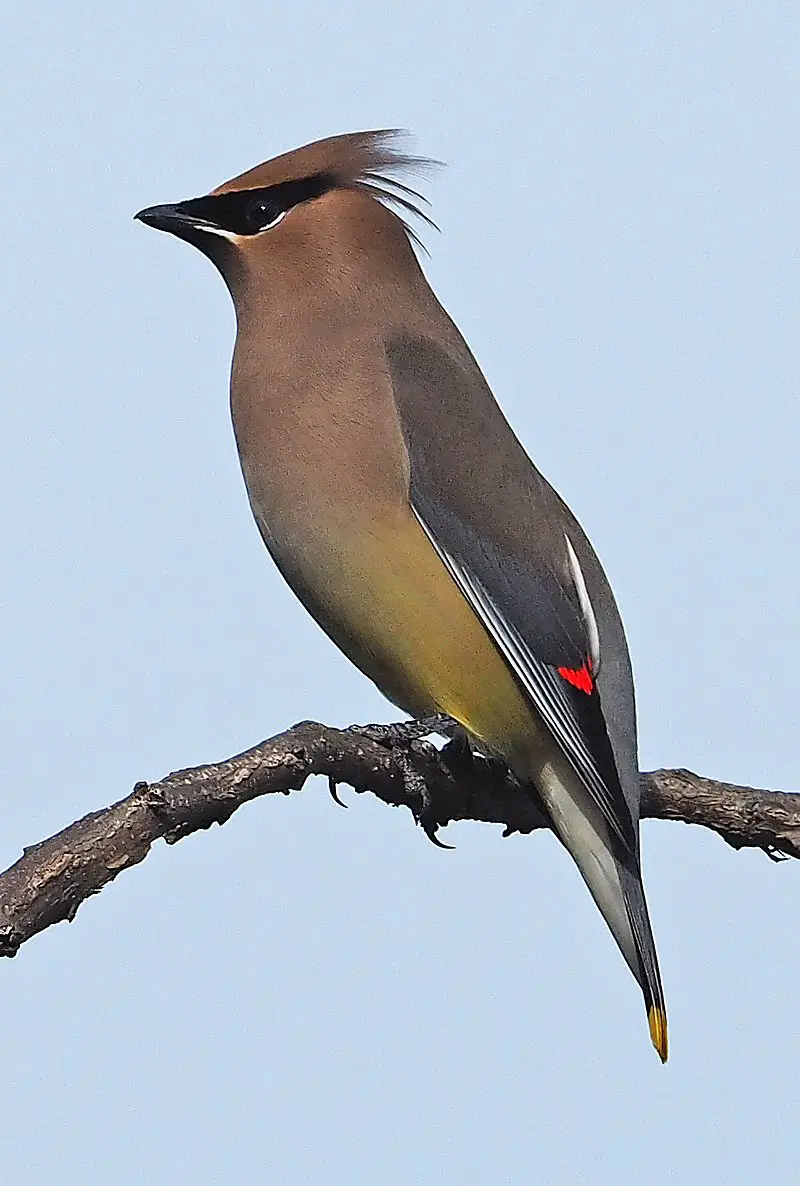
The Cedar waxwing, also known as Bombycilla cedrorum, is a medium-sized bird found in North and Central America.
They have a mixture of brown, gray and yellow feathers on their body, and their wings have wax-like tips.
These birds prefer open wooded areas in Southern Canada for breeding, and during winter, they migrate to the Southern part of the United States, Central America, and the far.
The Cedar waxwing is a member of the waxwing family of birds or Bombycillidae family.
They are known for their distinctive crest on their head and a black mask-like area around their eyes.
These birds are social creatures and can often be seen in large flocks, sometimes even intermixing with other bird species.
Their diet consists mainly of fruit and insects, and they are important dispersers of fruit seeds.
The Cedar waxwing bird is a beautiful and fascinating creature to observe in the wild.Scientific classification:
| Kingdom | Animalia |
| Phylum | Chordata |
| Class | Aves |
| Order | Passeriformes |
| Family | Bombycillidae |
| Genus | Bombycilla |
| Species | B. cedrorum |
Also Featured In: Birds That Live in Colorado, Birds Commonly Found in New York